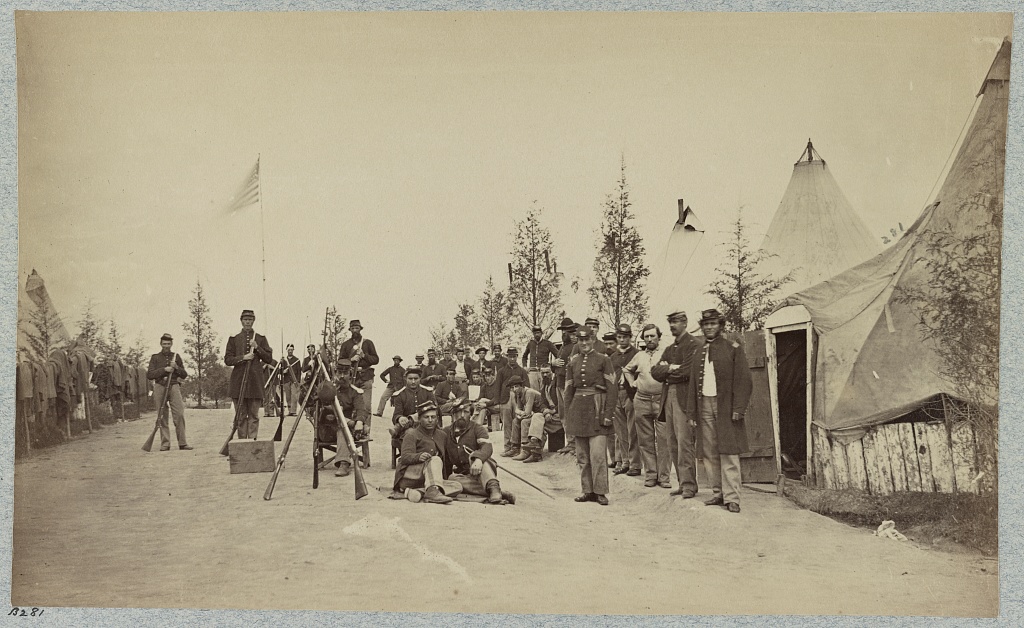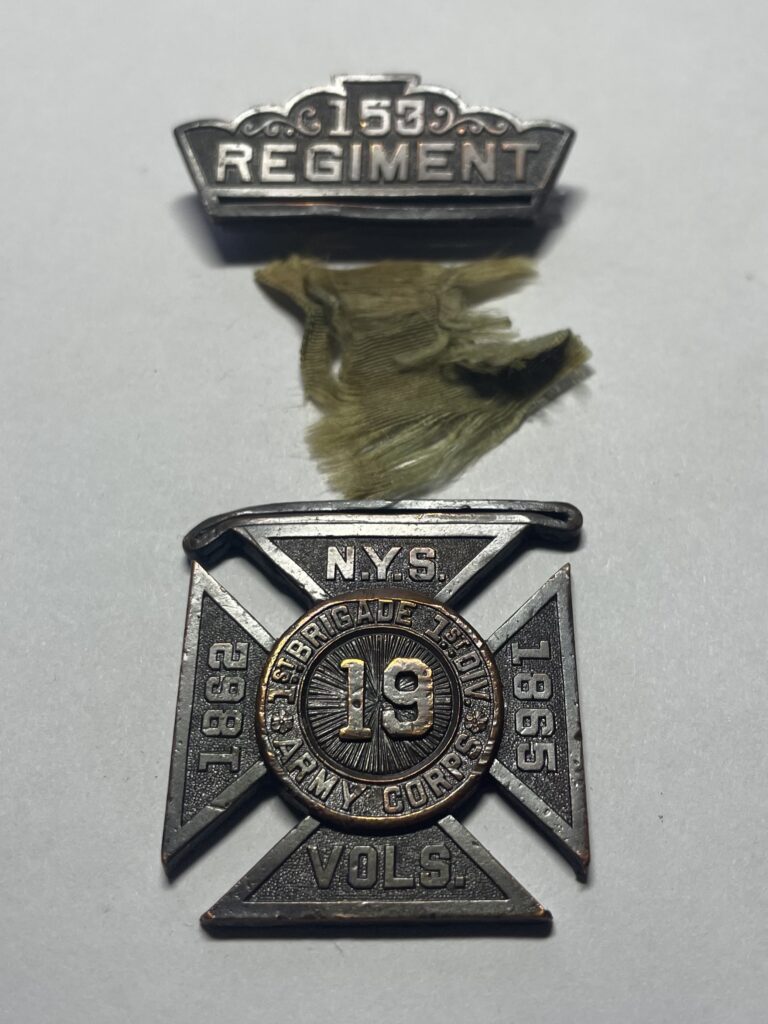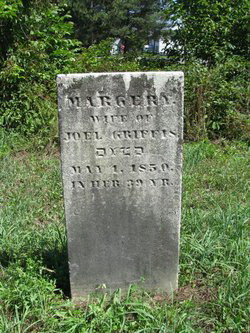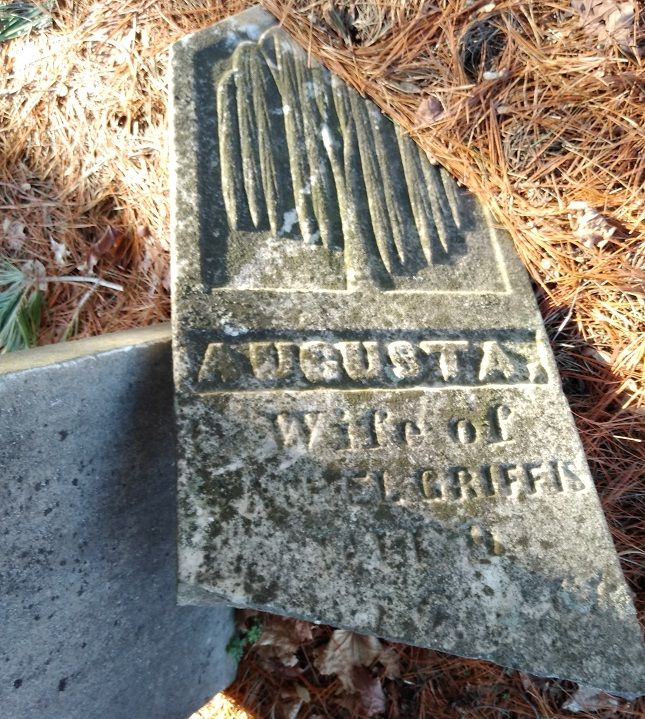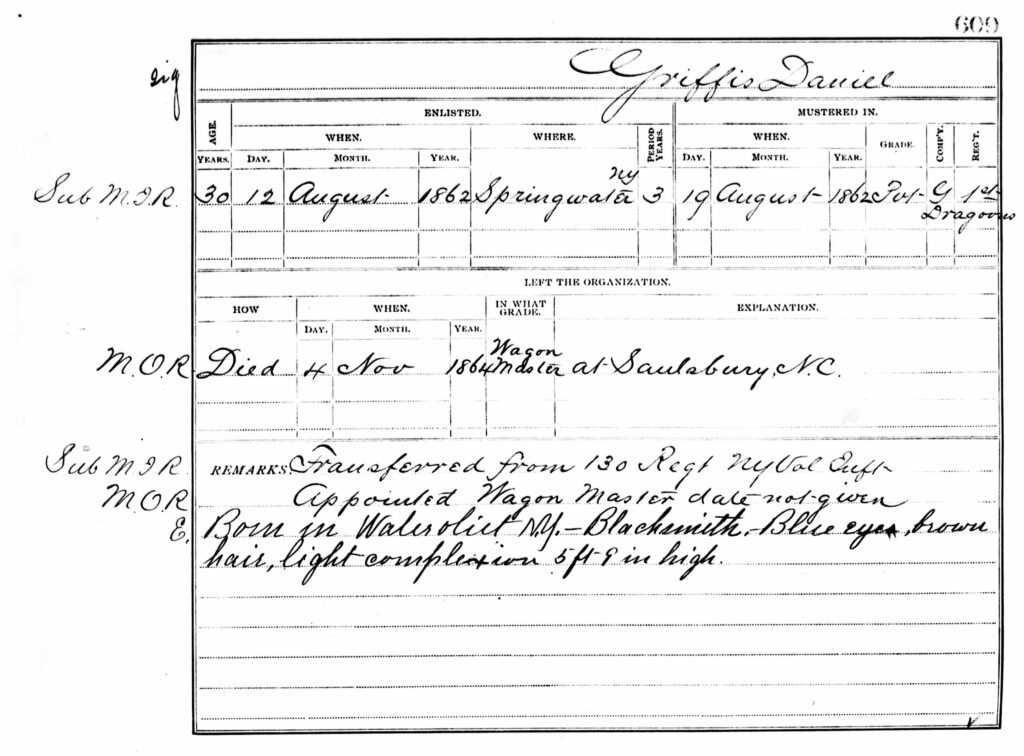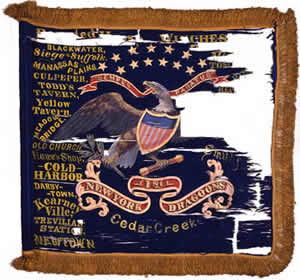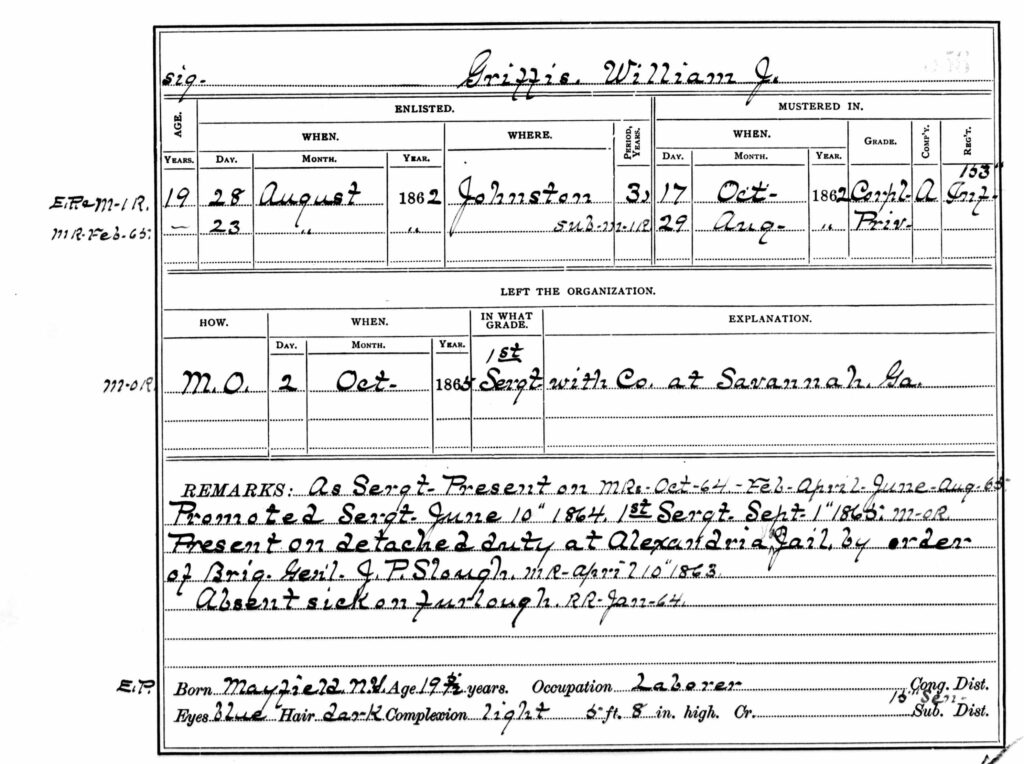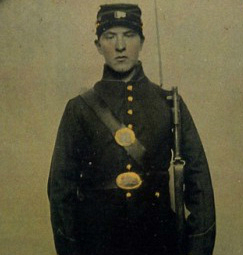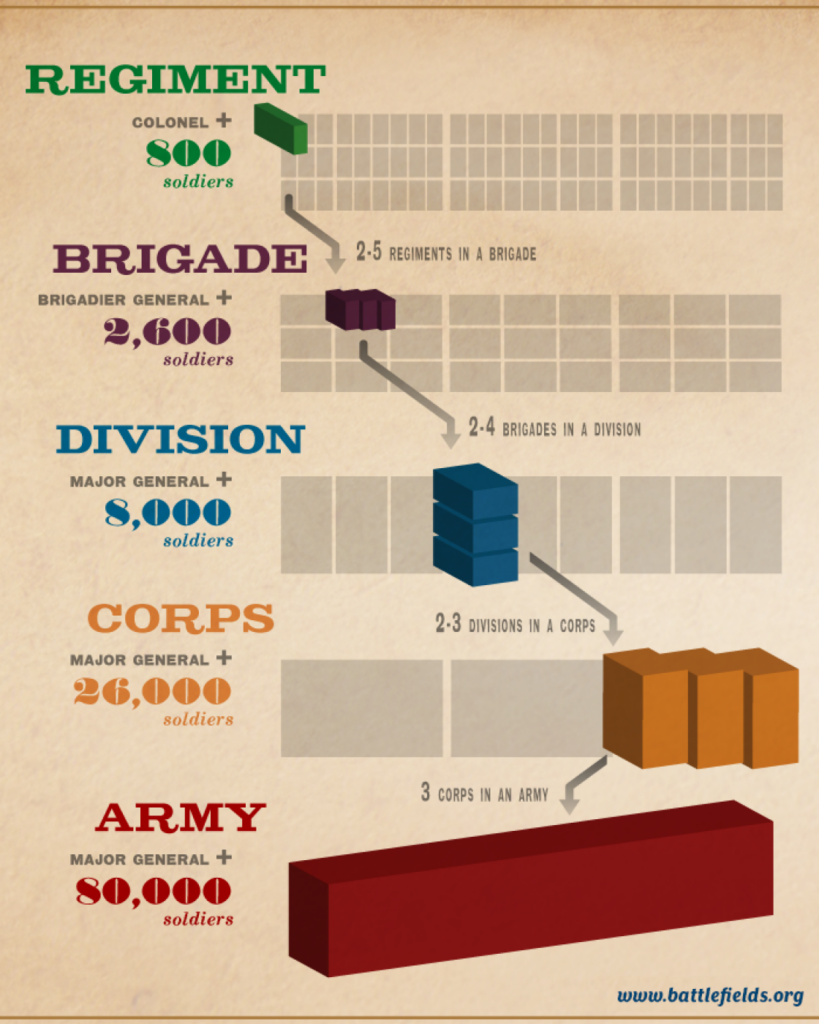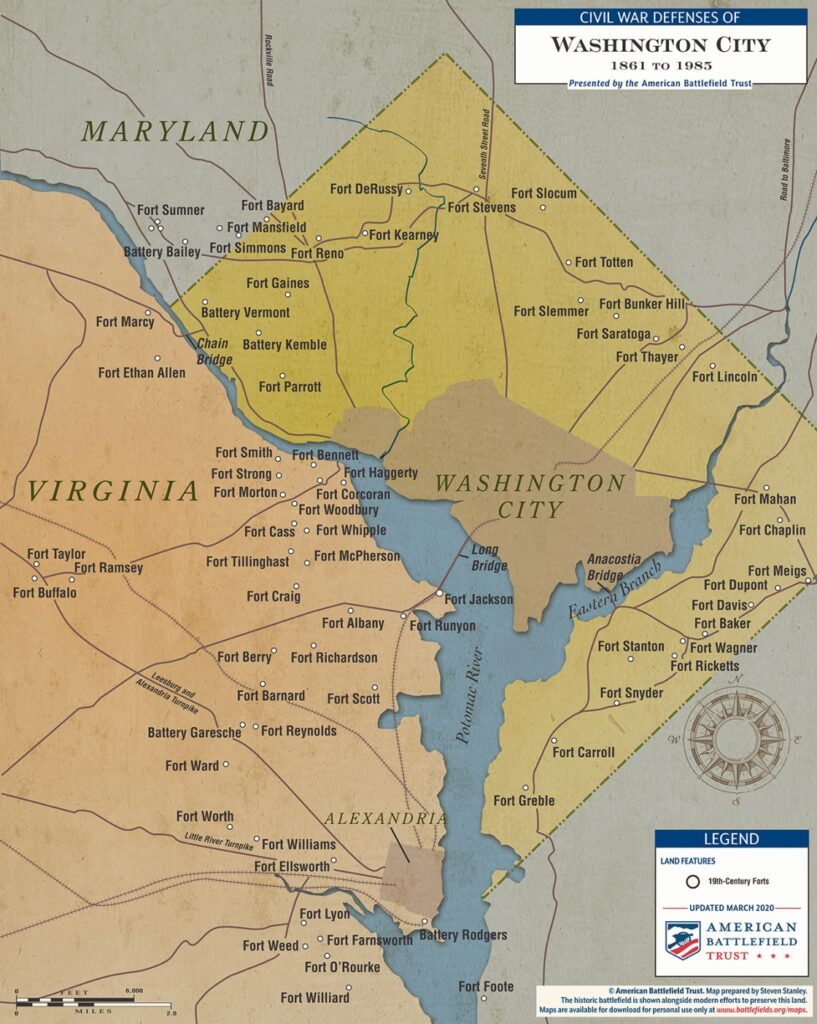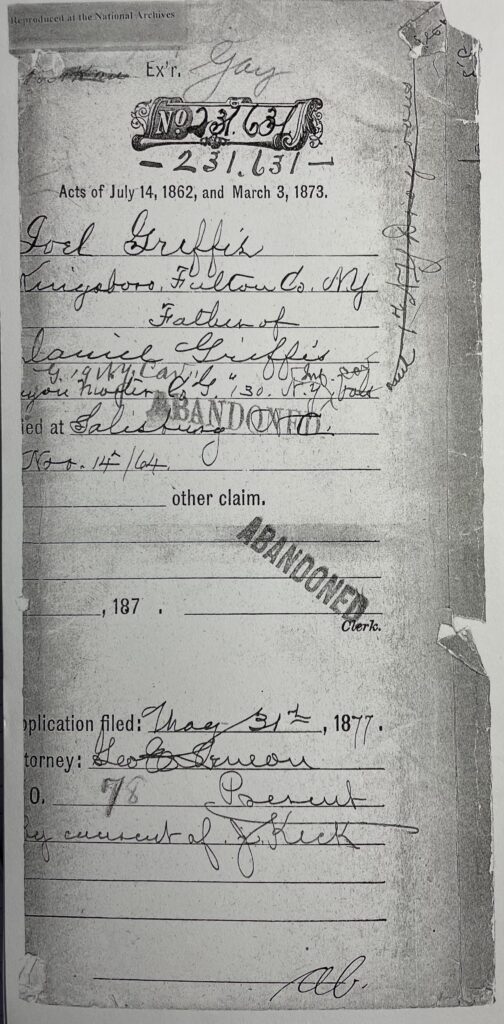Off to War: Two Paths Two Different Experiences
Daniel was the first to leave New York state. The 130th infantry regiment of New York headed south to Suffolk, Virgina. Their destination was deep behind enemy lines. Roughly 1,000 men departed on train from Portage, New York on September 6, 1862. The train stopped at Elmira, New York and the troops received their Enfield rifles and other equipment. However, the equipment was not issued until they reached Harrisburg, Pennsylvania. [1]
At Harrisburg, the troops made their first acquaintance with shelter, tents, and ‘army gray-backs’. Army gray-backs’ was another name for body lice. Body lice proliferated wherever armies gathered during the war and were so prevalent that they simply were accepted as a consequence of war. Whenever troops had downtime they deloused as best as they could. Discarding infected clothing became known as ‘giving the vermin a parole’ and turning one’s clothing inside out was a ‘flanking movement’. The insects knew “all the bugle calls”. The first use of the word ‘lousy’ can be traced to the civil war. [2]
They then made their way via train to Baltimore, Maryland. While part of the Union, Maryland was a slave state and public opinion against the Confederacy was not an unilateral position among locals.
“Public sentiment was divided; while some scowled and manifested extreme hatred, we found others intensely outspoken in their loyalty. Some who purchased and drank milk there became sick, leading to the belief that it had been purposely poisoned.” [3]
Proceeding to Washington, DC, the 130th regiment encamped for a few nights. During the war, the nation’s capital city filled with people and at times swelled to 200,000. In May 1861, troops, weapons, horses, and supplies began pouring into Washington. [4] Given its fragile, swampy environment, the military camp conditions quickly became muddied areas, susceptible to sickness. In September 1861, General George McClellan issued standing orders that soldiers in the Army of the Potomac be given hot coffee immediately after roll call as a “preventative of the effects of malaria”. Such orders did not appear to be effective. [5] Troops from the 130th referred to their camp in Washington, DC as being on ‘the border of a dried up goose pond’.
Map is part of a larger 1837 map: John Mcclellan. Map exhibiting the route of communication between Philadelphia & Charleston. [N.P, 1837] Map.
From Washington, the regiment embarked on an Union transport boat and traveled down the Chesapeake Bay to Fort Monroe. Fort Monroe was a military installation located in Hampton Roads, Virginia, on the Peninsula overlooking the Chesapeake Bay. It was the only federal military installation in the Upper South to remain under United States control throughout the Civil War and as such provided a strategic transport and control point for supplies. The regiment then traveled by train to their final destination on September 13, 1862 to Suffolk, Virgina.
“This place is about fifty miles southeast from Peterburg, and eight or ten miles from the North Carolina line. Here was being collected an offensive army to threaten the rebel capital from the south. This proved to be our army home for about nine months, as well as our training school for the severe and trying ordeals we were to pass through later on.” [6]
Meanwhile, Daniel’s brother William and the 153rd regiment left the state of New York on October 18, 1862. They may have had travel experiences similar to the 130th as they made their way southward to the nation’s capital. Unlike the 130th regiment, however, the trip to Washington D.C. was their final destination as Provost Guards in Alexandria, Virginia.
While their respective initial assignments to Suffolk and to Alexandria, Virginia were different, they were similar in terms of their shared experiences as being assigned military duty in cities in occupied Confederate territory. Suffolk was occupied by Union Troops from May, 1862, until the end of the Civil War. Alexandria was occupied the day after Virginia seceded in May, 1861.
“For the first two years of the war, Union commanders advancing into Confederate territory were without a clear understanding of how and when martial law should function and what relationship the army should have toward civilians, slaves, and private property.” [7]
“For most of the soldiers on occupation duty …, this was their first exposure to a real “secesh” (secessionist), to blacks, and to the physical landscape of the South. Most of them felt their surroundings to be alien and unfriendly. For their part, the people of Alexandria looked with disfavor upon the troops in their midst. They bridled at requirements for oath-taking (civilians were required to sign oaths of allegiance to the Republic when requesting to travel in and out of the city) and resented nearly all the laws and regulations imposed by the military. By the end of the war, Unionist sentiment had been nearly eradicated.” [8]
Daniel’s First Half of His Tour of Duty: Engagements & Skirmishes in Virgina and a Transition to the Calvary
Daniel’s infantry regiment was assigned to the 1st Division, VII Corps of the Army of the Potomac. The 1st Division was commanded by Gen. Michael Corcoran. In the ensuing months, the 130th New York regiment ‘cut their teeth’ in battle and were engaged in the major encounters of the Battle of Deserted House and took part in the Siege of Suffolk in April and May 1863. During his first year and a half of service, Private Daniel Griffis witnessed and possibly participated in 10 major engagements in northern Virgina. His regiment was in the thick of the war at the time. After the engagement at Manassas Plains, he possibly was a wagon master and may not have been on the picket lines or the leading edge of skirmishes:
- Blackwater, VA December 2, 1862
- Near Blackwater, December 28, 1863
- Deserted House (or Kelly’s Store), VA January 30, 1863
- Siege of Suffolk, April 11 – May 4, 1863
- South Quay Road, VA April 17, 1863
- South Quay, VA June 12, 1863
- Franklin, VA, June 13, 1863
- Blackwater, VA, June 16-17, 1863
- Baltimore Cross Roads, VA July 4, 1863
- Manassas Plains, VA October 17, 1863
- Culpepper Courthouse, VA November 20, 1863
- Barnett’s Ford, VA December 2, 1863
- Barnett’s Ford, VA January 20, 1864
- Barnett’s Ford, VA February 6-7, 1864 (This is when Daniel Wrote a letter to his father Joel)
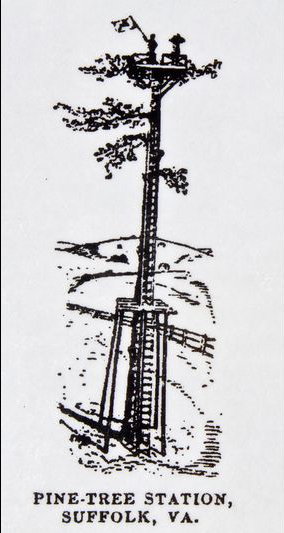
After the battle of Deserted House in January 1863, aside from numerous skirmishes along the picket lines where they may have camped, the regiment was not under fire until the Siege of Suffolk. The two intervening months of February and March were consumed with work on building fortifications around Suffolk and picket line duty under the direction of Major General Peck. The trenches and fortifications that Daniel and his fellow troops built around Suffolk spanned about 15 miles in the shape of a horseshoe with the open end toward Norfolk and the Great Dismal Swamp. The Nansemond River curved like a snake to form the natural north boundary.
Nearly 60,000 men faced off across the Nansemond River beginning April 11, 1863 when Confederate troops under Lt. Gen. James A. Longstreet attacked the heavily fortified Union stronghold in Suffolk. (Drawing on the left: Union Signal Corps tower: “Pine-Tree Station” was one of many Signal Corps towers erected to protect the Union lines in Suffolk.)
Despite Confederate Longstreet’s efforts to surround Suffolk by land and water, he abandoned the takeover attempt of the city based on Union Major General Peck’s preparation of building forts and rifle pits surrounding the city and having gunboats in the Nansemond River. Instead he and the Confederate troops settled down to a regular siege that lasted until May 4, 1863.
“On the afternoon of April 11, our pickets were rapidly driven in or captured, and from Terry’s front, on the west, where our camp was located, we beheld long lines of rebel infantry as they came up and filed off to the right and the left of the South Quay road. At the same time two other columns were marching on other roads to strike us from both the north and south… . The whirl of the long roll was heard in every camp, and in all directions troops were seen scurrying to the forts and rifle pits. Our brigade, under General Terry, immediately took position in the trenches, where we remained under the siege. All through the first night our ears caught the sound of picks and shovels, and what was our surprise in the morning to see before us, just across the river, a long line of rifle pits full of rebel sharpshooters…. The popping up of heads and dodging down when we saw a puff of smoke reminded one of woodchuck hunting.” [9]
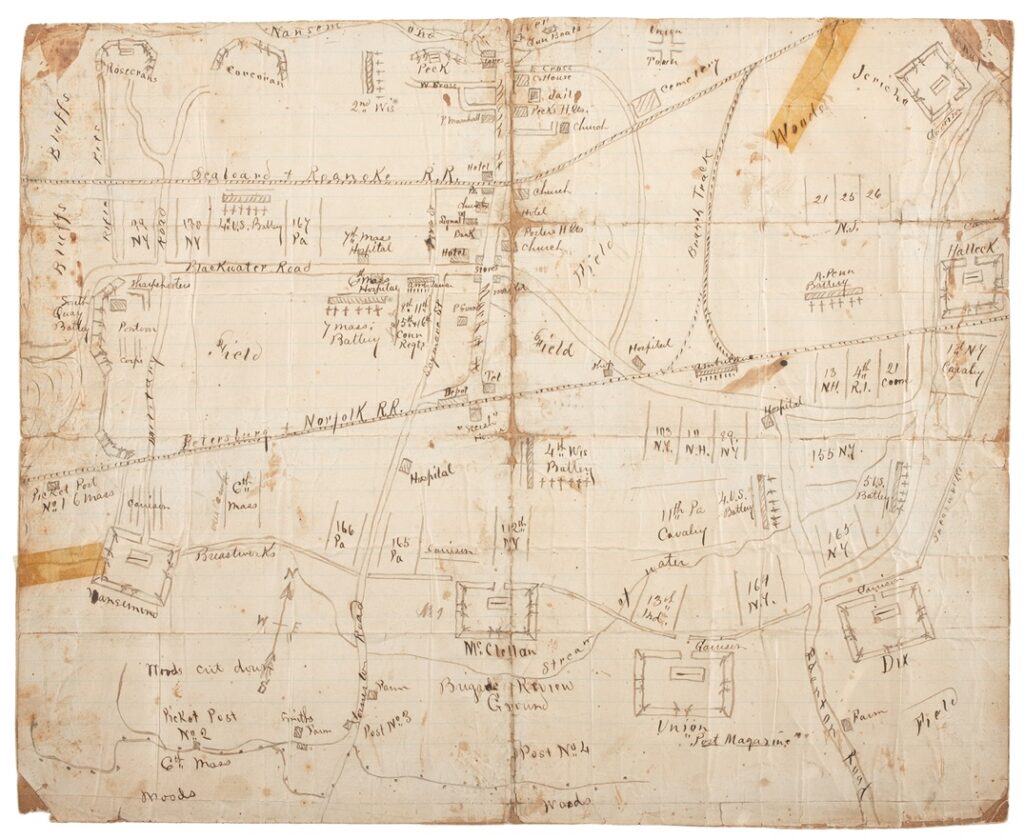
Map of Suffolk
This is a pen and ink map, 12.5 x 15.25 in., on two sheets of notebook paper laid on cigar paper. It is an highly detailed map showing the position of each regiment present at Suffolk, as well as the locations of Union sharpshooters, batteries, hospitals, breastworks, garrisons, churches, and cemeteries. The Seaboard & Roanoke and Petersburg & Norfolk Railroads are also identified. The map belonged to George William Gragg, a private with Company K, 6th Massachusetts Infantry, his regiment was stationed in Suffolk, Virginia from September 1862 until June 1863, attached to the 7th Army Corps, Department of Virginia.
Daniel Griffis’ 130th New York Infantry regiment was situated in the upper left hand corner of the map next to the Seaboard and Roanoke RR line. . Click on Map for Larger Image
While there were numerous skirmishes during the siege of the Union encampment in Suffolk, there were interesting incidents that occurred along the front, reflecting the basic essence of what it is to be human even during war, as described below. The trading of goods and swapping of stories were essentially a ‘courtship ritual’ when picket posts were in place and the troops occupied an area for an extended period of time. Within the life situations soldiers were placed, basic trust developed and humans reached out to other humans on the other side and soldiers opened up about the war, their families, and life in general. [10]
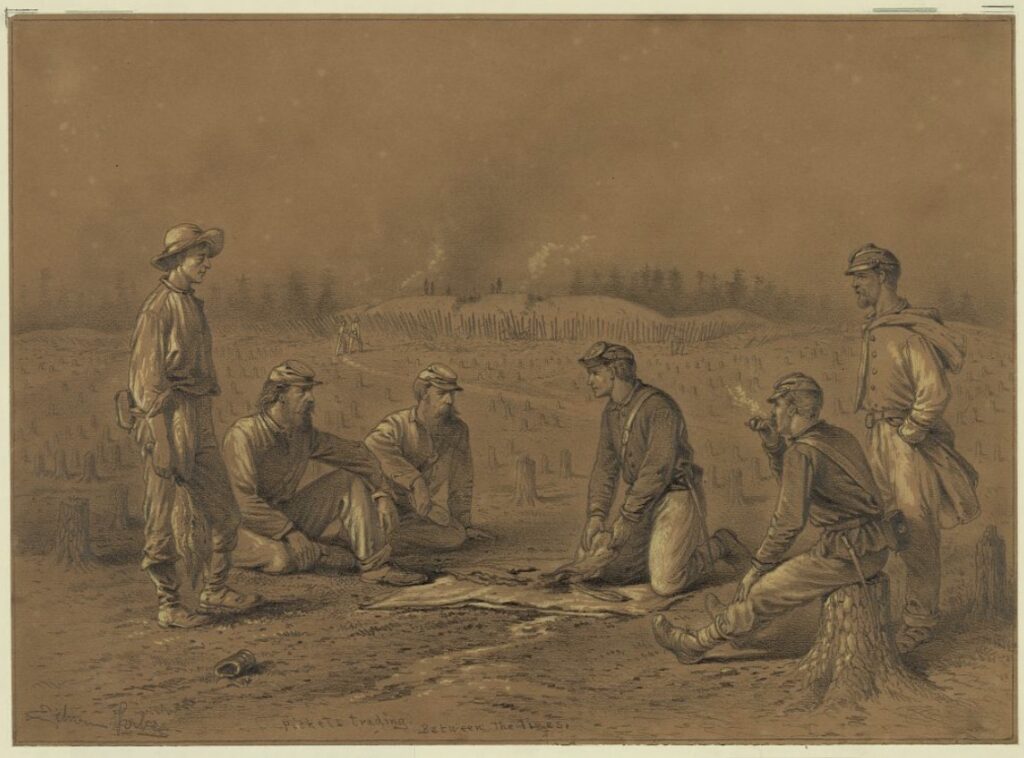
“Sometimes, however, the monotony was broken by an armistice between the two hostile lines, when the men on both sides would swarm out of the entrenchments and enjoy a season of friendly intercourse, telling stories, cracking jokes, or singing for each other’s entertainment. Occasionally they would cross over and exchange hardtack, coffee, salt, and other things for tobacco. It was quite a fashion to exchange coat buttons.” [11]
After the siege, the regiment engaged in a six day reconnoissance on the Blackwater where they participated in a number of skirmishes at South Quay and Franklin “where we had more skirmishing… Comrade A.F. Robinson relates that as we entered the captured pits, one of the regiment found a violin, and while the fight was in progress, commenced playing and dancing.” [12]
After their 20 mile home march back to Suffolk on June 18, they struck up their tents, packed up and left Suffolk on June 19, 1863. “we bade farewell to our camps, and to the tune of “The Girl I left Behind Me”, we marched to the cars.” [13] They took a train to Norfolk, boarded a boat and arrived at Yorktown the following day.
The 130th regiment marched from Yorktown to White House Landing. During their three weeks of ‘masterly inactivity’ they recorded victories with a force of 1,050 calvary within rebel lines to Hanover Courthouse, destroying bridges, capturing or killing 125 of the enemy, securing horses, mules wagons, supplies and “$15,000 of Confederate bonds’. Among their prisoners was the son of General Robert E. Lee, Brigadier General William F. Lee.
Leaving Yorktown July 11, they arrived in Washington the following day; and then to Federick City, Maryland on the 16th when Colonel Gibbs reported to General Meade. The regiment then marched to Warrenton on July 25th.
Daniel Assumes Wagon Master duties
“The strenuous efforts of Colonel Gibbs had at length been rewarded with success, and our regiment was the recipient of honors bestowed upon no other in the history of the war. There were regiments of mounted infantry, but no other instance in which an absolute transference from infantry to calvary occurred. The special orders from the war department touching this transfer, bear date July 28, 1863… .” [14]
Special Orders Number 205, dated August 2, 1863, signed by General Meade, directed the 130th New York Volunteers to proceed to Manassas Junction and form a camp of instruction for the purpose of ‘being recognized and receiving its arms and equipments. … The regiment is attached to the calvary corps, and reports and returns will hereafter be rendered accordingly.’
Daniel’s regiment was converted to a cavalry regiment on July 28, 1863, and designated as the 19th Regiment New York Volunteer Cavalry. The 19th Cavalry was officially re-designated as the 1st Regiment New York Dragoons on September 10, 1863. It was probably during this period that Daniel became a wagon master.
While infantry units had wagon masters and teamsters to manage supplies and ambulance units, Daniel’s military files suggest he did not become a wagon master until the regiment was transformed into a calvary unit. This was a massive transformation for the regiment and for the individual soldiers. Everyone in the regiment was personally impacted and undoubtably given new assignments. His role as wagon master, as documented in pension records, is evident in January and February 1864. [15]
The work required of wagon masters and teamsters was stressful, backbreaking and often dangerous. One infantryman admitted that all the drivers labored in “one of the most wearing departments of the service.” Wagon masters maintained the wagons and the teams of horses or mules, directed the teamsters who drove individual wagons and may as well have driven wagons. Regulations required wagon masters and teamsters to grease the axles or repair the wheels; feed, water, and curry the horses; and possibly to load and unload cargo. [16] Union military orders indicated there should be one wagoner for an infantry or calvary company of approximately 100 soldiers. [17]
Daniel probably managed a six mule wagon along with the others duties associated with a wagon master. The standard wagon utilized during the Civil War was a six mule or horse wagon. The six-mule wagon was the “coin of the realm of Civil War logistics”. [18] The origin of the six mule wagon can be traced to the military demands for a standardized four mule transport wagon in the late 1830’s. Constructed along the same lines as the earlier four mule wagon, the six-mule wagon was built using the same basic specifications with the exceptions of heavier wheels, larger axles and increased dimensions to the lower side rails on the body. The wagons weighed about 2,000 pounds and could carry approximately the same load. However, with the addition of more pairs of draft animals, the loads could be more easily transported over long distances without wearing out the team as quickly. [19]
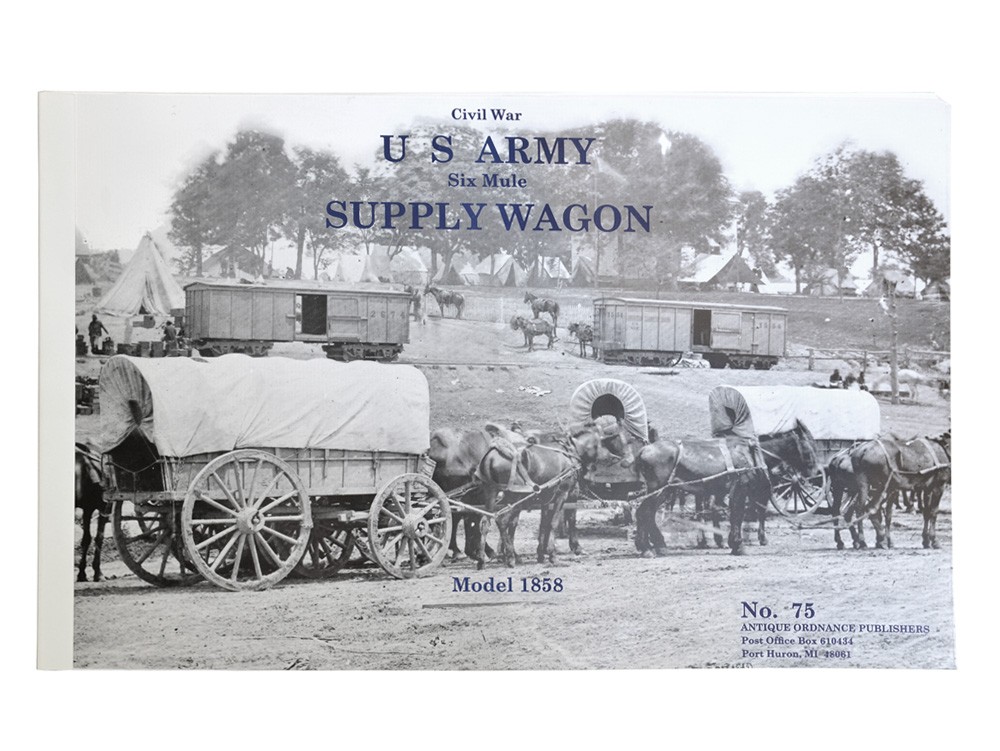
The first actual contract for the Six-Mule Wagon was on February 9, 1855. [20] By 1858, with all the reports received back on the design, the final Quartermaster specifications were printed. These specifications would remain unchanged until the end of the Civil War. Based upon knowledge gained during the Civil War, a new set of Six-Mule Wagon Specification were prepared in 1865.
A six-mule team “was hitched in three spans. The largest mules, the wheel pair, were hitched closest to the wagon. The swing pair was in the middle. The leaders, probably the smallest and supposedly the smartest, were in front. Wagons were driven by a muleskinner who rode the left-hand mule (i.e., facing forward) nearest to the wagon. This position was occupied by the near-side wheel mule, also called the near-pole mule. The left file of mules … was the near-side and the right file was the off-side. The near-side leader was connected to the off-side leader by an iron pole. The mules were steered by a single rein running back from the near-side lead mule. The team turned to the left when the driver yelled “Haw” and pulled steadily on the rein. A shout of “Gee”, accompanied by quick jerks on the rein, caused the team to turn to the right. Shouting “Yay” sent the team straight ahead.”[21]

As indicated in the above quote and indicated in Earl Hess’ incisive work, this drawing by Edwin Forbes provides an accurate depiction of how mule driven wagon teams were driven in the Civil War. The driver is seated on the left rear mule rather than on the box of the wagon. The driver controlled the other mules by means of using the reins and a whip. [22]
During most of the war, each regiment had, on average, six wagons that were dedicated to its immediate needs. [23] One of the wagons hauled the surgeon’s medical stores. Another carried the tents and the baggage of the field and staff officers. The third wagon carried the baggage of the line officers. The fourth wagon hauled the pans and kettles of the line companies. The fifth and sixth wagons carried rations. Brigades, divisions and army corps were apportioned additional wagons to carry baggage, rations, forage, hospital supplies, ammunition, entrenching tools and quartermaster supplies.
The mobility of the army depended on the carrying capacity of its wagons. Toward the end of the war, the Army of the Potomac carried ten days of rations and ordnance stores for an entire campaign. The number of wagons per regiment varied depending on circumstances and military campaigns and there are a variety of Union military General Orders that qualify the use and deployment of wagons. [24]
As the war progressed, experience varied and fine tuned the army‟s knowledge of the carrying capacity of a six-mule wagon. For example:
“An army wagon will carry conveniently, with what forage is usually added, about 2,500 pounds, making with the forage 3,000 pounds, which is about the greatest capacity over moderately good roads; even this amount will be found very great if the march is continued long each day or requires to be at all rapid.” [25] “…I have found that an army wagon will haul from 700 to 800 complete rations, if well packed, and 1,200 of the ordinary marching ration.” [26] Brigadier General Ingalls, the Chief Quartermaster of the Army of the Potomac, said that “One wagon will carry 1,200 rations hard bread; 2,000 rations coffee (1 barrel); 1,800 rations sugar (1 barrel); 300 rations (two-eights pound) pork (1 barrel, 1 box, 25 pounds); 1,200 rations salt (1 box, 45 pounds); 36 rations (9 pounds to ration) oats (3 sacks); gross weight, 2,674 pounds.” [27]
Wagon masters and teamsters generally worked under the quartermaster. Quartermasters had little patience with incompetence or mistakes, and these hard pressed supply czars often vented their frustration on those driving the teams, who in turn cracked their whips, alternately eased and yanked the leather reins, and made “the air blue with profanity addressed to their mules, individually or collectively, so that the anxiety to get through was felt by all the moving forces in the train,” as one observer put it. [28] Brigadier-General Butterfield said: “The quartermaster should have his train thoroughly disciplined and under his control to move it with as much facility as a battery of artillery can be moved.” [29]
Soldiers may have considered driving wagon as an escape from the front lines. However, teamsters and wagon masters transported all sorts of valuable goods and were under constant danger of capture or worse, even when they had large escorts of armed troops. The ponderous size of wagon trains made them inviting targets and easy to find. [30]
“Among the teamster and wagon man’s many enemies were shoddy, stump-filled roads, sucking mud that threatened to swallow up teams and wagons whole, and lame or otherwise injured animals. Drivers often found themselves down in the dirt, digging out their wagons or helping mechanics with repairs. They were also responsible for the care of their hard-working teams and constantly fed their animals from the sacks of forage they lugged in each 2,500- to 2,800- pound wagonload.“ [31]
Daniel: Manassas to Mitchell’s Station
The regiment moved by rail August 3, 1863 from Warrenton Junction to Union Mills and on August 6, 1863 established their first camp at Manassas Junction to start their training as a calvary unit. They received their horses September 13, 1863 just one month before they were to break camp. For a short period after their transfer, the regiment was known as the 19th New York Calvary. Their quartermaster Abram Lawrence suggested the name “First New York Dragoons” which was adopted and confirmed by the governor of New York. The order announcing the change was read on October 10, 1863 during a dress parade.
“During our two month’s sojourn in camp of instruction at Manassas, we were almost incessantly always annoyed by the notorious guerrilla, Mosby, and his band of thieving cut-throats, who were always prowling about the outskirts of our camp, like a pack of hungry wolves, ready to pounce upon and capture or kill our men and horses. Notwithstanding our strong picket line and the exercise of vigilance, we suffered from his depredations. If suppressed on one side of the camp, he bobbed up serenely on the other. He was the new version of Paddy’s flea – ‘Put yer hand where he is, and he ain’t there.’ “ [32]
After breaking training camp at Manassas, the regiment rejoined the Army of the Potomac and had their first engagements a calvary unit October 13, 1863 at Manassas Plains.
“Since breaking camp have been in our saddles from fifteen to twenty hours every day, not stopping two nights in one place. One night we rode for hours in a terrific storm: in fact, it was a rainstorm and hurricane combined, as we were almost blown off of our horses. For three days we have traveled in our water-soaked clothing, but today, by sun and fire, we have dried off somewhat. Most of the time we have subsisted on hardtack and raw pork, and having opportunity to cook or make coffee.” [33]
The First Dragoons had a major engagement at Culpepper Courthouse November 20, 1863.
“On the 14th and 15th (of December) we had another long and tiresome chase after Mosby, who had run off an infantry wagon and the mules. Starting at sundown we rode rapidly all night, scarcely stopping until we had made nearly forty miles; but nary a Mosby did we get…we followed the trail, the tracks became fresher and more distinct until the prize seemed almost within our grasp, when suddenly, as if the earth had opened and swallowed it up, in some inexplicable and mysterious manner all traces were lost. Even Major Scott, who had the sagacity of an Indian was completely nonplussed.” [34]
At the end of 1863 and the beginning of 1864, notwithstanding the continued demands of outpost duty and scouting expeditions in the Virginia countryside, Daniel and the Dragoons were able have a ‘four month sojourn’ in permanent quarters at Mitchell Station, Virgina. Around December 20, 1863, the regiment was directed to construct winter quarters near Culpepper, Virginia. After a week’s worth of work they were ordered to move their camp five miles nearer the front at Mitchell’s Station which was on the Orange and Alexandria Rail Road line. ” To say that there was no grumbling, or even profanity, indulged in, would be such a stretching of the truth. “ They started making their camp on December 27th, 1863 at their new location.
“After assurances that this would be our permanent camp for the winter, the men went to work with renewed energy, devoting all the time spared from picket duty to the construction of winter habitations where, during our period of hibernation, we could have better protection that that afforded by our little shelter tents. … Though not permitted, woodchuck like, to snugly cuddle down until spring, it was nevertheless no small consolation to have comfortable burrows to crawl into when returning, cold and wet, from our severe turns of picket service on the Rapidan.” [35]
William’s First Year: Guarding Prisoners & the Nation’s Capital and Chronic Sickness
Within the capital itself, President Lincoln initiated a comprehensive program of security measures and government reforms that he dubbed “cleaning the devil out of Washington.” [36] The nation’s capital was in between Maryland, a slave state, and the northern border of the Confederate state of Virgina. The Union army used the city to mobilize and supply the Army of the Potomac, defend the eastern seaboard, and launch military thrusts toward Richmond. Believing that the loss of the Union’s capital would lead to immediate defeat, the Confederacy targeted Washington throughout the war. During the winter of 1861-62, work began on a 37 mile ring of fortifications around the city. This defensive ring eventually had 68 forts connected by twenty miles of trenches and 800 cannons clustered in 93 artillery positions. [37] The government’s fear for the security of the nation’s capital kept thousands of troops, much to the dismay of army leaders in the field, within the capital’s defense for the remainder of 1863, including the 153rd New York Infantry Volunteers.
To enforce martial law and suppress anti-government subversion and dissent, the Union army established an extensive provost guard. Lincoln empowered the provost guard to enforce both military and civil law in Washington and Alexandria and, among other duties, to arrest civilians upon suspicion of disloyalty and subversion. [38] As part of this national strategy, the 153rd New York Volunteers were deployed to the capital to be part of this effort to protect the capital area as provost guards.
“Provost Marshall troops or the Provost Guard, as they were also known, were the military police of the Union Army during the American Civil War. They had a separate chain of command from the regular and volunteer troops answering only to the Provost Marshall of each Division or Corps. While in the field they acted as the security detachment for Division and Corps Headquarters. They protected Headquarters units and provided men to guard captured Confederates on their way to the rear. They provided security against Confederate guerrillas and raiders. They were often the only law enforcement available to civilians after the Union Army arrived. It was vital that the Union Army provide men willing to be fair and honest in their dealings with the soldiers and the local civilian populace.”[39]
The responsibilities of the provost guard were:
- “Suppression of marauding and depredations, and of all brawls and disturbances, preservation of good order, and suppression of disturbances beyond the limits of the camps.
- Prevention of straggling on the march.
- Suppression of gambling-houses, drinking-houses, or bar-rooms, and brothels.
- Regulation of hotels, taverns, markets, and places of public amusement.
- (Executing) Searches, seizures, and arrests. Execution of sentences of general courts-martial involving imprisonment or capital punishment. Enforcement of orders prohibiting the sale of intoxicating liquors, whether by tradesmen or sutlers, and of orders respecting passes.
- (Guarding) Deserters from the enemy.
- (Guarding) Prisoners of war taken from the enemy
- Countersigning safeguards.
- (Issuing) Passes to citizens within the lines and for purposes of trade.
- (Managing) Complaints of citizens as to the conduct of the soldiers.” [40]
From their inception as a regiment and up to October 18, 1862, the 153rd New York Volunteers were under the command of Colonel Duncan McMartin. Between October 1862 and February 1863, the regiment was assigned guard and provost marshal duty in Alexandria, Virginia. They were under command of Colonel Clarence Buell of the 169th New York volunteers who headed the Provisional Brigade, Abercrombie’s division, Defenses of Washington.
The regiment was subsequently transferred on February 2, 1863 to the District of Alexandria, Defense of Washington to continue their provost guard duties in the nation’s capital and were under the command of Brigadier General John Slough. During this detail they were residing in Camp Slough which was west of Alexandria. Specific locations that they performed their duties were: Alexandria City Patrol, Hunting Creek which included guarding a bridge across the Potomac River, General Slough’s office (City Provost Marshal Office – photograph below) [41] , Alexandria Jail [42] , the Contraband Depot [43] , and the Water Battery [44] .
Guard and Provost Marshal Duty Locations of the 153rd New York Volunteers Under General Slough
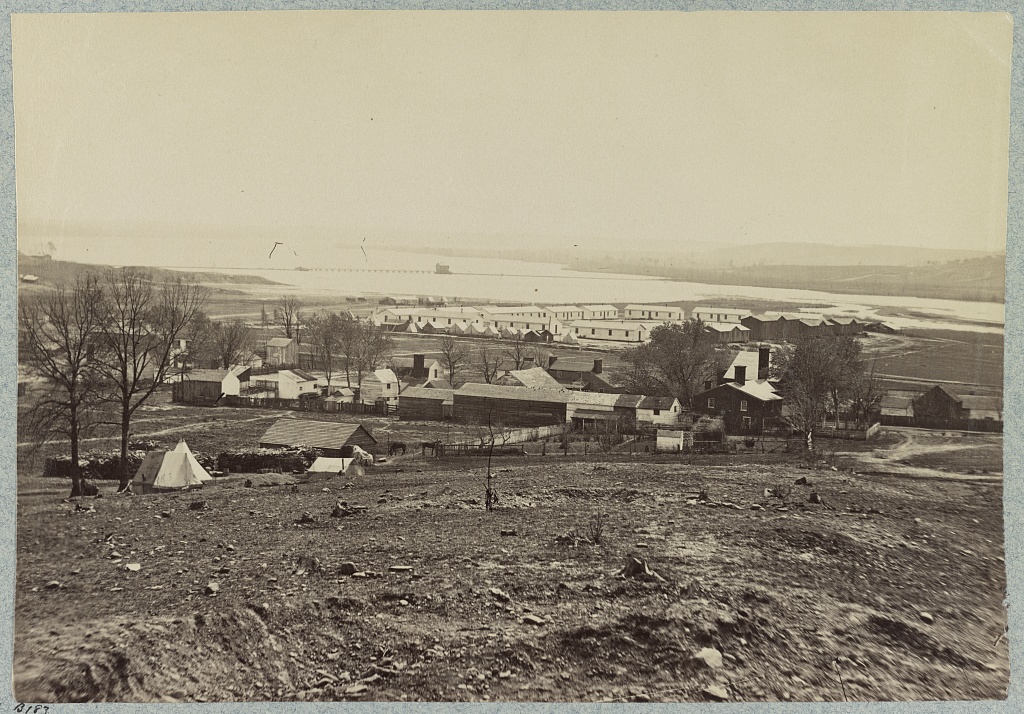
Hunting Creek
Hunting Creek Bridge, near Alexandria, Va. United States Alexandria Virginia, None. [Photographed between 1861 and 1865, printed between 1880 and 1889] Photograph.
Click on Photograph to larger view.
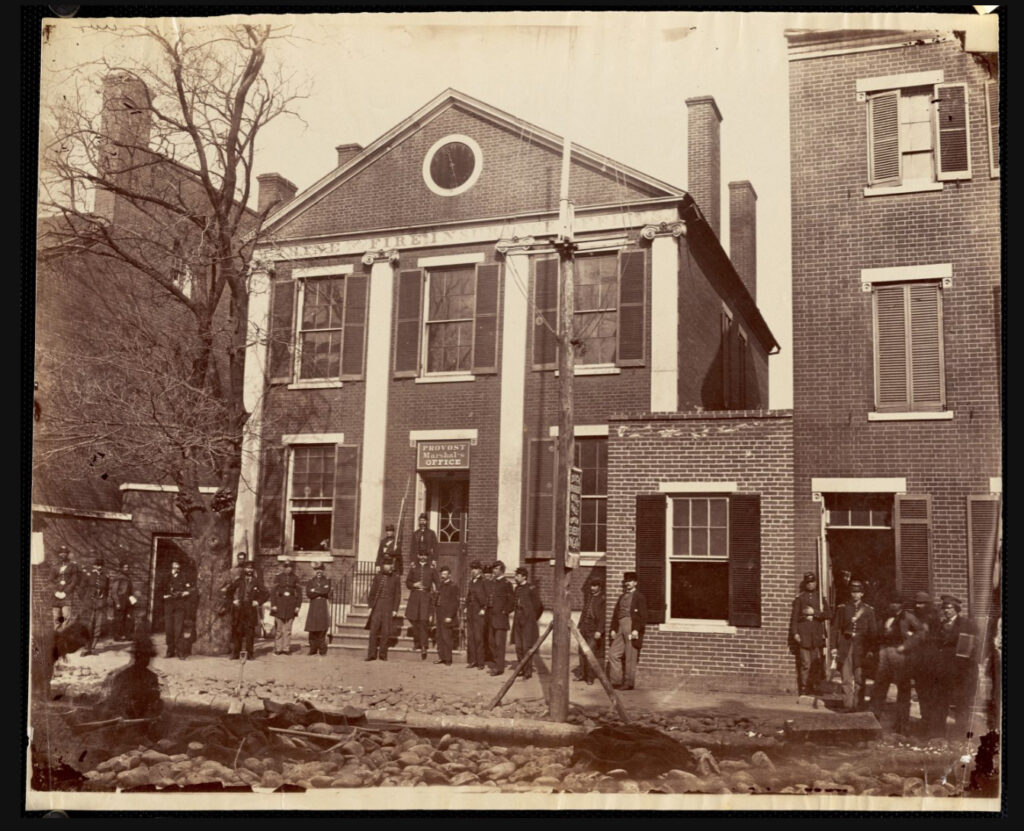
City Provost Marshals Office
Provost Marshall’s Office, Alexandria, Virginia 1861-1865: Series: Mathew Brady Photographs of Civil War-Era Personalities and Scenes, 1921 – 1940 Record Group 111: Records of the Office of the Chief Signal Officer, 1860 – 1985
Click on Photograph for larger view.
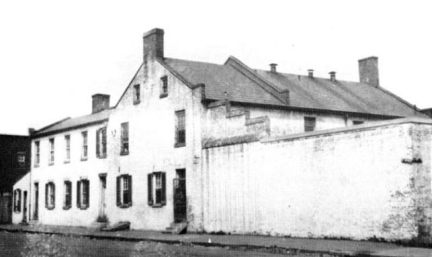
Alexandra Jail
The Old Jail was located at the northeast corner of Princess and North St. Asaph streets. Those housed in the jail included convicted criminals, debtors, and enslaved people. During the Civil War when the Union occupied Alexandria, military prisoners were also held there.

Contraband Depot
Source: Mathew Brady Photographs of Civil War-Era Personalities and Scenes, 1921 – 1940
In February 1863, Military Governor John Slough ordered one part of the building to be turned into a hospital for contrabands. ‘Contrabands’ were slaves who escaped to Union lines during the Civil War
Click photograph for larger view.
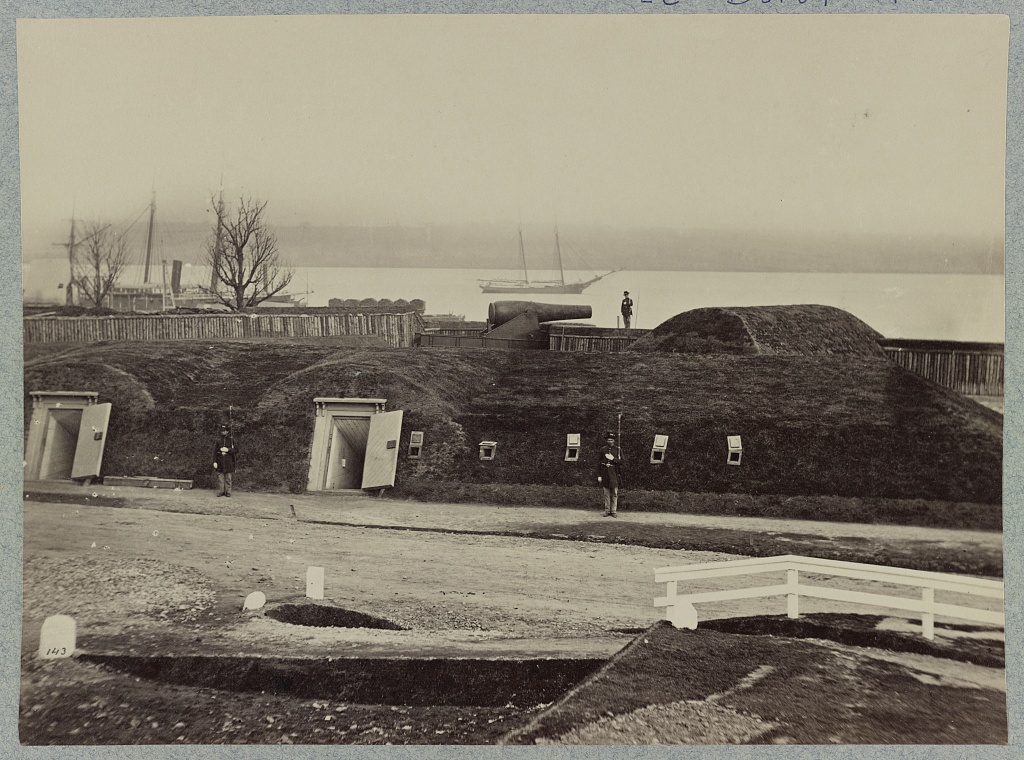
Water Battery
Battery Rodgers, Potomac River, near Alexandria. United States Alexandria Virginia, None. [Photographed between 1861 and 1865, printed between 1880 and 1889] Photograph.
Click on Photograph for larger view
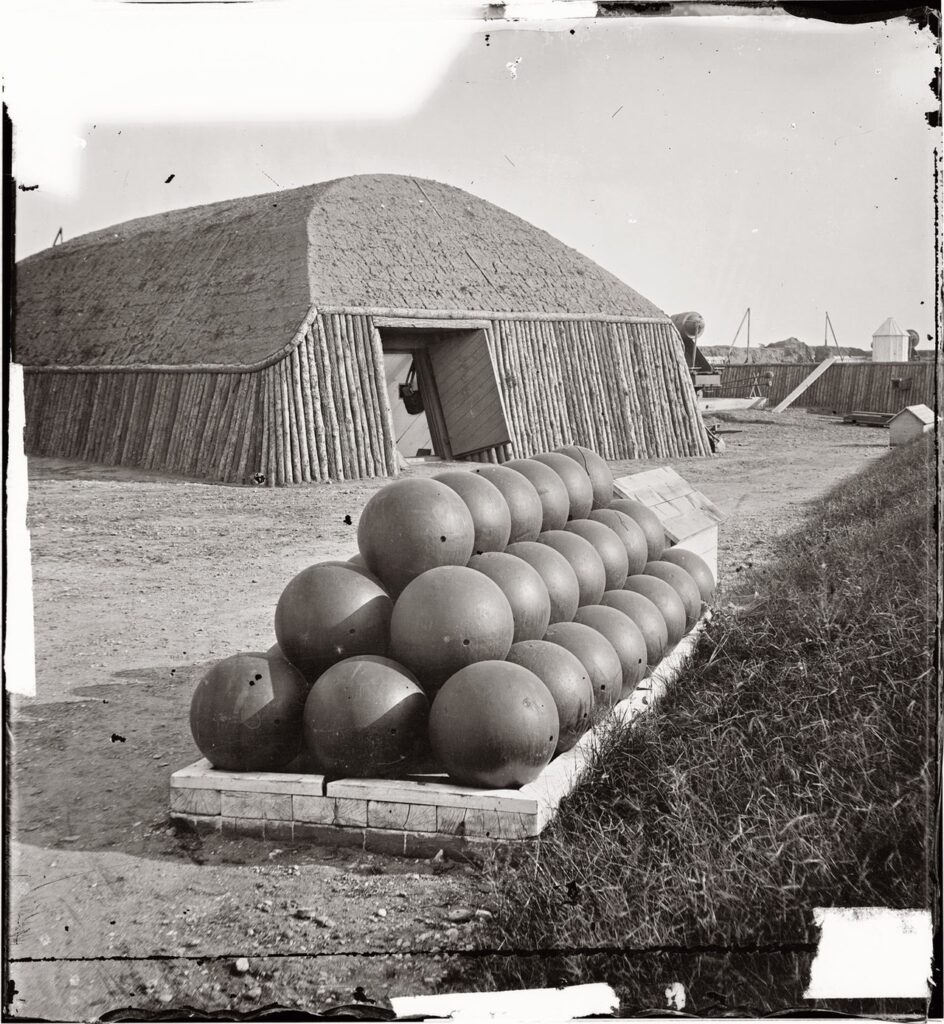


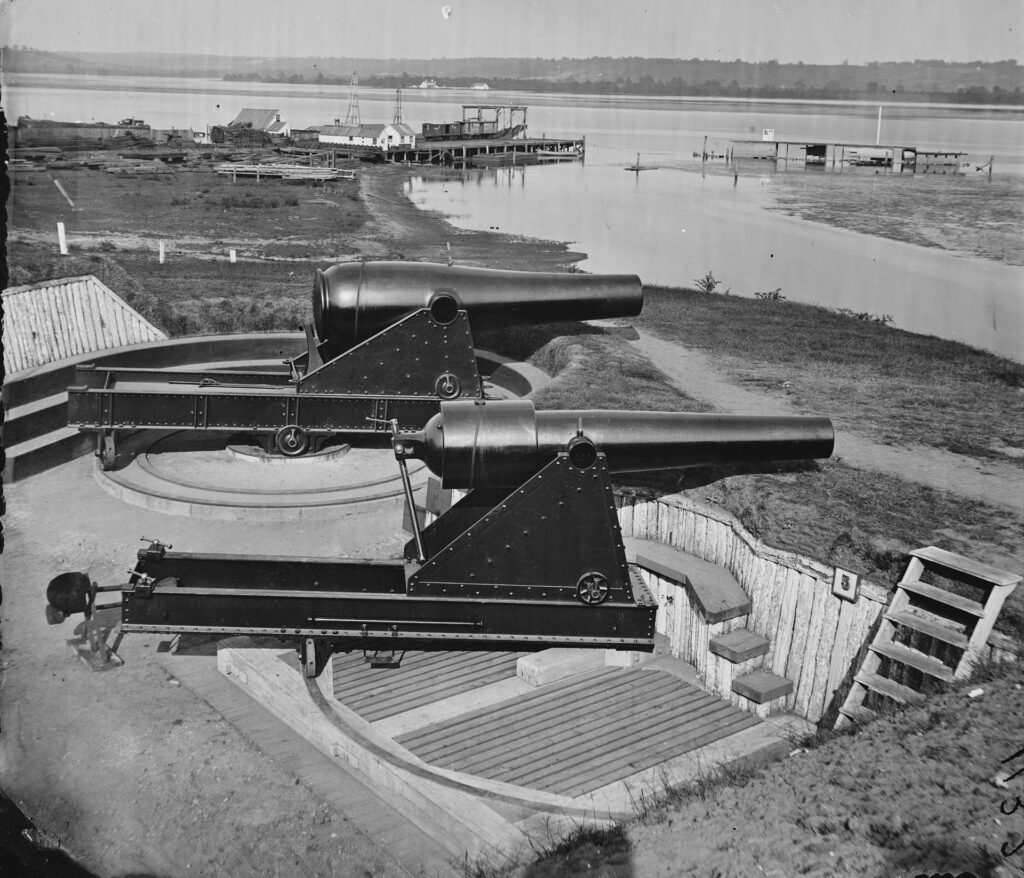
Water Battery – Battery Rodgers, Alexandria, VA, Library of Congress
Old City Jail or Alexandria Jail was one of five Union prisons that were used in Alexandria, Virginia during the Civil War. Two were previously used as prisons: the Old City Jail on Saint Asaph Street and the Birch Slave Jail at 1315 Duke Street. The other three prisons were large buildings housing the former Green furniture factory at Prince and South Fairfax Streets, the Odd Fellows Hall at 218 North Columbus Street, and the massive Mount Vernon Cotton Mill at 515 North Washington Street, renamed the Washington Street Military Prison. [45]
William Griffis arrived in Alexandria, Virgina on October 22, 1862. A fellow Company A soldier and Mayfield neighbor, John Dye, recalled on their day of arrival that “…the night was very cold. We had no tents to protect us from the inclemency of the weather. (William) caught a heavy cold and was sent to (the Arlington) Jail to do inside duty not being able to do outside duty.“[46]
Based on available historical records, William Griffis spent most of his time at the end of 1862 and the following four months in 1863 guarding prisoners at the old Jail in Alexandria. In January, 1863 William had contracted a cold that turned into chronic laryngitis. He was diagnosed as having ‘catarrhal laryngitis’. Catarrhal laryngitis in civil war era parlance was ‘inflammation of the mucous membranes’ with no specific cause. He may have also had pneumonia. [47] He was assigned guard duty at the Old City Jail for light duty and reported to the regimental hospital for medicine on a recurrent basis.
William’s sickness was not unique. With a sea of army tents surrounding the Capitol for a radius of three miles, massive numbers of soldiers coming from all Union states, and the absence of modern water and sewage systems, infectious diseases were endemic in Washington, DC. During the war, epidemics of smallpox, typhoid fever, and measles plagued the wartime city. In December 1862, the Colonel of the 153rd ordered the vaccination of the entire command for smallpox. [48] Around this time Sarah Wakeman, who was a soldier of the regiment, wrote home to indicate that two men died in her company and 30 in her regiment also died purportedly due to measles and “there is quite a number sick”. [49] The human toll was heart rending and included the Lincolns’ 11-year-old son Willie, who succumbed to typhoid fever early in 1862. Lincoln himself nearly died from smallpox in the weeks that followed his Gettysburg Address in mid 1863. The likelihood of succumbing to disease was very high when stationed in the nation’s capital.
As indicated in the muster roll documents in William’s military file (below), William was detailed to the Alexandria Jail pursuant to an Order by Brigadier General Slough on February 25 or 26, 1863. William was assigned to the Jail for guard duty from end of February through June of 1863. He was stationed at Camp Slough, Alexandria, Virginia with the regiment but his duties were detached from the regiment’s assigned duties.

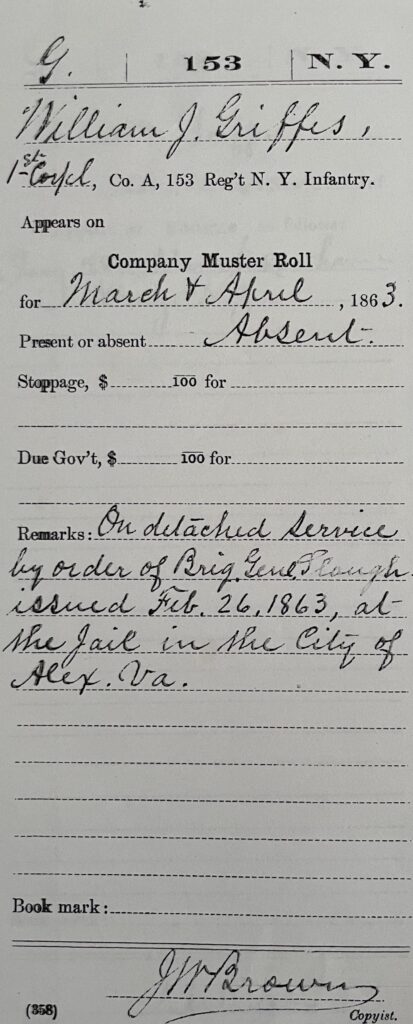

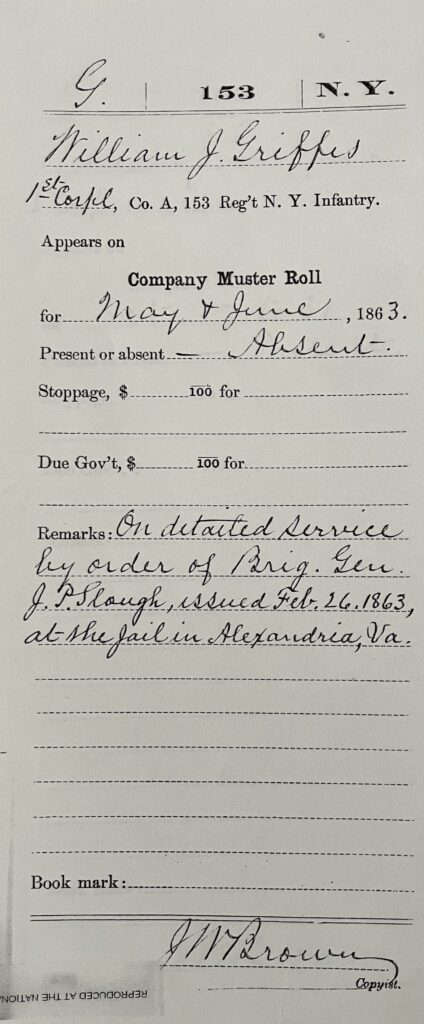
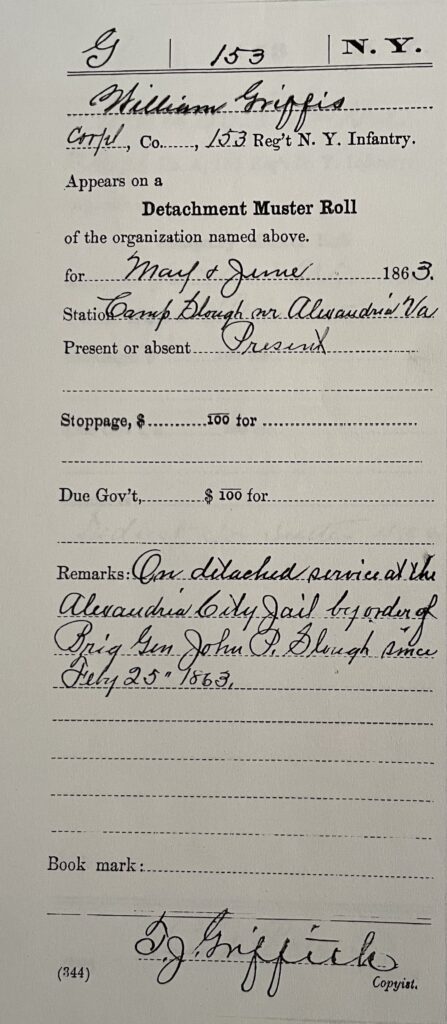
In anticipation of expected draft riots in Washington City , a special order was issued to transfer the 153rd regiment from Alexandria to Washington City. [50] In July 1863, the 153rd was transferred to Washington City and placed under the commend of Brigadier General John Henry Martindale. The regiment moved into the barracks on Capital Hill as unattached troops in the 22nd Army Corps, Department of Washington. As private Rosetta Wakeman wrote in an undated letter to her father, the regiment’s living quarters were perhaps an improvement from Camp Slough in Alexandria.
“Dear Father,
“I will Write a few lines today and let you know What kind of quarters we have got. We are in Barracks. They are good ones.
“My Co. and Co. C is in one building. The buildings is two story high. The place for sleep is upstairs and down below is a room for to do the Cooking and a place to eat. We can get good Water to drink outside of the guard. It is Well Water. We Can get Water to Wash With inside of the guard. It is Water that comes from the river. The river Water is a little salty, for the tide sit up the river as far as George town.
“I can’t think of any more to write Present so good-by.“ [51]
When the regiment was transferred to Washginton, D.C. on July 21, 1863, William Griffis followed 14 days later and was assigned to the Railroad ‘Washington’ Depot detail. This reassignment of the regiment was undoubtably a swift military reaction to the New York draft riots.

Source: Library of Congress, Washington, D.C.
The New York city draft riots (July 11 – 16, 1863) were the culmination of the sentiment among working class whites and proslavery supporters of the Democratic Party. The enactment of the Emancipation Proclamation in January 1863 capped two years of increasing support for emancipation in New York City. From the time of Lincoln’s election in 1860, the Democratic Party had warned New York’s Irish and German residents to prepare for the emancipation of slaves and the resultant labor competition when southern blacks would supposedly flee to the north. The Emancipation Proclamation was confirmation of their worst perceived fears. In March 1863, stricter federal draft laws added fuel to the fire. All male citizens between twenty and thirty-five and all unmarried men between thirty-five and forty-five years of age were subject to military duty. The federal government entered all eligible men into a lottery. Those who could afford to hire a substitute or pay the government three hundred dollars could avoid enlistment. Local events came to a head in July.
When recruiting for the army began in July 1863, a mob in New York wrecked the main recruiting station. Then, for three days, crowds of white workers marched through the city, destroying buildings, factories, streetcar lines, and private property. They marched through the streets, forcing factories to close, recruiting more members of the mob. They set the city’s colored orphan asylum on fire. They shot, burned, and hanged African Americans they found in the streets. Many people were thrown into the rivers to drown. On the fourth day, Union troops returning from the Battle of Gettysburg came into the city and stopped the rioting.[52]
Based on the letters of Sarah Rosetta Wakeman in September 1863, [53] the 153rd Regiment was responsible for guarding five locations in the Washington, D.C. area: the 153rd regimental camp, Carroll prison, the Railroad Depot where William Griffis was assigned, City Hall, and City guard. City Hall was where the military draft operations and physical examinations were conducted.
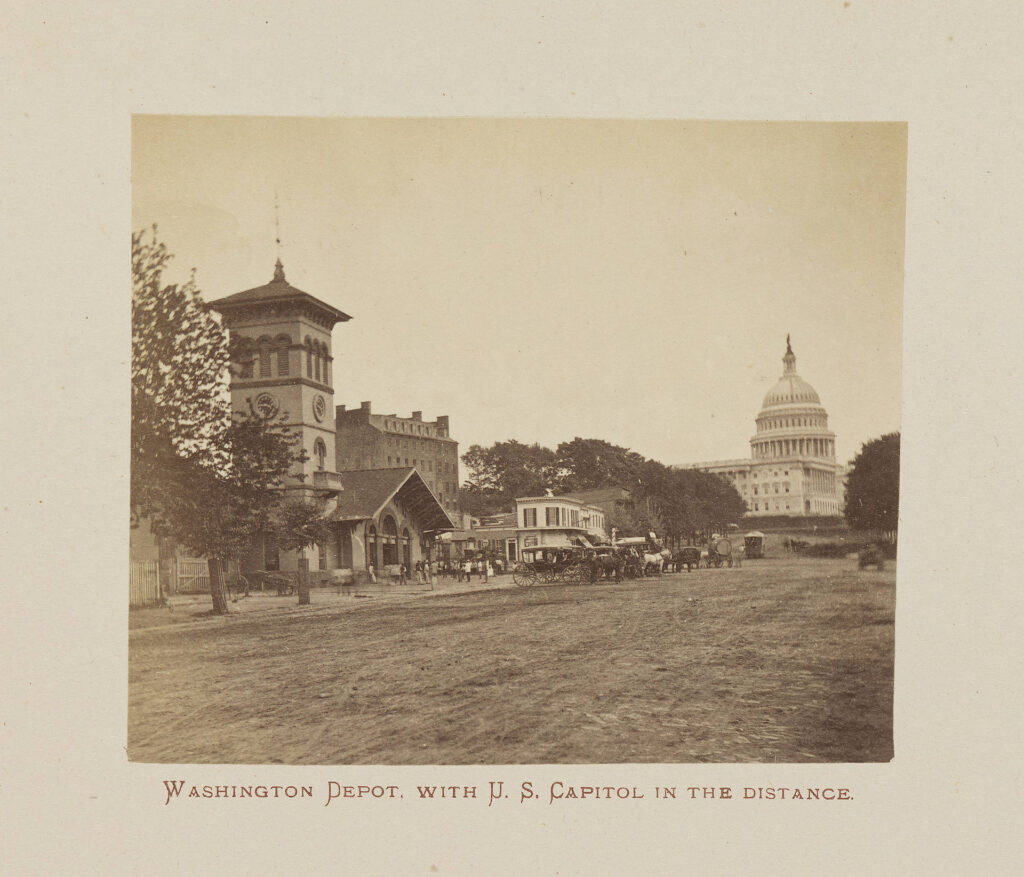
Washington Depot, with U. S. Capitol in the Distance (1872)
The photograph was taken after the Civil War. [54] On December 2, 1863, the last section of the Statue of Freedom was put in place on top of the dome. The interior of the dome was finished in January 1866 capital dome was not completed until after the war. [55] Click photograph for larger view.
Provost guard duty at the Washington Depot must have provided William Griffis with a wide variety of daily interaction with troops coming from and going to a multitude of places. In a letter to her father, Sarah Wakeman, who was from Company H of the 153rd, wrote,
“Our regiment has to guard Carroll Prison and the Depot and City Hall. When I am down to the Depot and see so many men and women agoing North it makes me homesick”. [56]
From late April 1861, the arrival of Union troops at the Washington Depot was constant.
“During the Civil War, there were scenes which it is to be hoped will never be witnessed again – troops passing through the city by thousands, most of them debarked a few yards north of the New Jersey Avenue Station.” [57]
The federal government erected a ‘Soldier’s Rest’, a precursor of a USO station, near the rail depot to provide temporary accommodations and meals for arriving troops.
“Meals were prepared and served to soldiers, and at one time no less than sixteen regiments and smaller bodies of troops were furnished with meals within twenty-four hours.” [58]
The Washington Depot also witnessed dramatic increases in rail transport of livestock and supplies. Incoming freight increased from an average of eight cars per day in 1860 to more than 400 cars per day between October 1861 to March 1862. In October 1861 a new freight warehouse, measuring 20 by 300 feet, was constructed just north of the depot. To further accommodate the increased traffic, a Y, to turn engines, and additional side tracks were laid in the depot yard in 1864. [59]
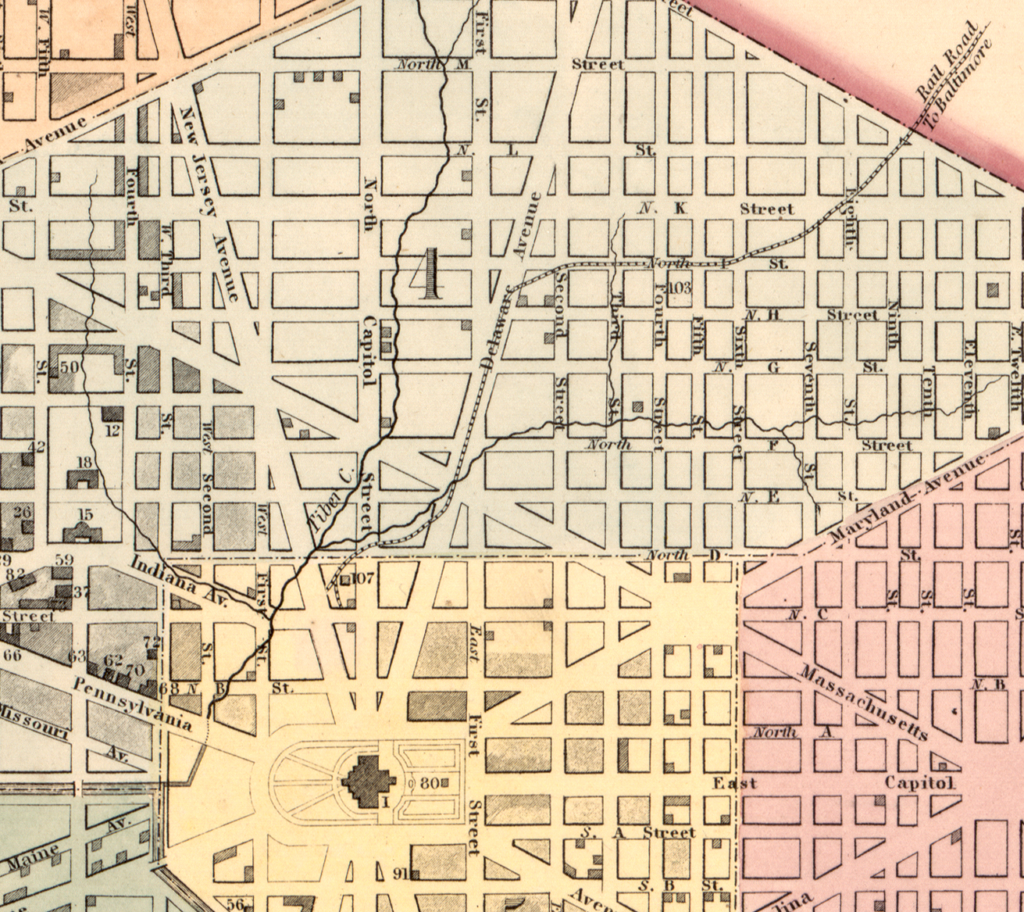
Detail of a 1859 Map of Washington, showing the Baltimore and Ohio (B&O) Railway and its termination into the Railroad Depot. [60] Click photograph for larger view.
The Railroad Depot is labeled 107 on the map. By the time of the Civil war, the B&O Railroad controlled 513 miles of track and used 236 locomotives, 128 passenger cars and 3,451 freight cars [61]

Carrol Prison (Old Capital Prison)
John Singleton Mosby the “Gray Ghost“, before leading his Battalion of Mosby Raider’s, was captured as a confederate scout on July 20, 1863 while waiting for a train at the Beaverdam Depot in Hanover County, Virginia.
Mosby was imprisoned in the Old Capitol Prison for ten days before being exchanged as part of the war’s first prisoner exchange. He perhaps was guarded by the 153rd New York volunteers and while William Griffis was assigned to the Washington Depot.
The following year Mosby’s Raiders captured william’s brother Daniel Griffis on a wagon train raid. Source: Library of Congress .
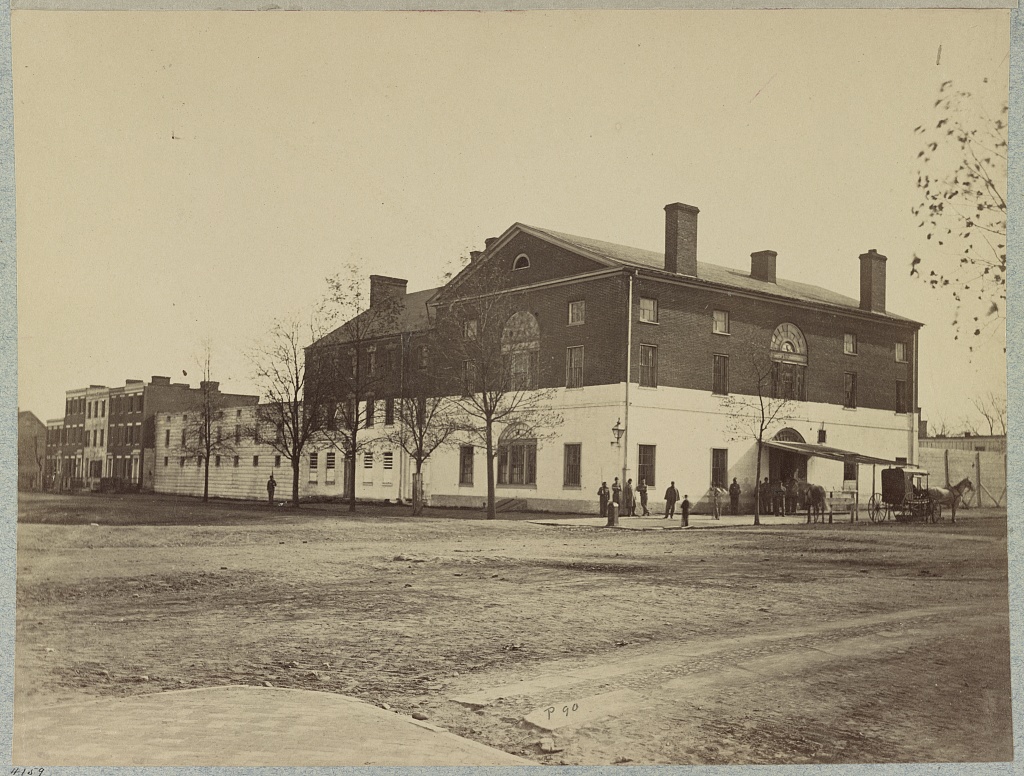
The Old Capitol prison, Washington, D.C.. Photograph by William Redish. (Photographed between 1861 and 1865). Library of Congress Prints and Photographs Division. In 1929, the site was acquired by eminent domain and the brick building was razed to clear the site for the U.S. Supreme Court Building. Click on image for larger view.
Carrol Prison originally was called The Old Capitol (or “old brick Capitol“) and was constructed in 1815 as a temporary meeting space for Congress after the British burned the U.S. Capitol in 1814. During the Civil War, the Old Capitol was repurposed as a prison for Confederate prisoners of war, spies, blockade runners, and Union army officials convicted of insubordination. The warden of the prison was William P. Wood, and during the prison’s service, Wood commented that 30,000 prisoners passed through its gates. Following his service as warden, Wood became the first chief of the Secret Service. [62]

Confederate spy Rose O’Neal Greenhow (1817–1864) and her daughter Rose imprisoned in Old Capitol Prison
Photograph by Mathew Brady- Levin Handy. Photographed 1862. Library of Congress Prints and Photographs Division. Click on image for larger view.
In an undated letter to her father, Rosetta Wakeman references Rose O’Neal based on her guard duty: [63]
“I have just thought of something new to Write to you. It is as following.
“Over to Carroll Prison they have got three women that is Confined in their Rooms. One of them was a Major in the union army and she went into battle with her men. When the Rebels bullets was coming like a hail storm she rode her horse and gave orders to the men. Now She is in Prison for not doing aCcording to the regulation of war.
“The other two is rebel Spies and they have Catch them and Put them in Prison. They are Smart looking women and [have] good education.
“I Can’t think of any more to Write at this time. Write soon as you get this letter.”
Rosetta Wakeman
John D. Brownell served with William Griffis in Company A of the 153rd regiment. Brownell mustered in as a private in Gloversville, New York on August 30, 1862 and was made a second lieutenant the following day, August 31, 1862. Within Union volunteer regiments, enlisted men elected many of their officers and governors appointed the rest. The practice of electing officers was reduced to a small scale by 1863. Brownell evidently was well liked or known to be elected as an officer. Brownell was promoted to first lieutenant on July 7, 1863. [64] Brownell indicated in a letter after the war that William Griffis was plagued with recurrent medical issues associated with “disease of the lungs” throughout his military career. He indicated he was present with William in February 1863 in Alexandria when he was sick
“…with disease of the lungs he having contracted the same from exposure while in the line of duty and was on the sick list and absent from the regiment for about five months (he was detailed to the Alexandria Jail ) … he was then sent to do light duty at the Rail Depot at Washington … subsequently he was again taken sick and was sent to (the) regimental hospital on Capital Hill and from there was sent home on sick furlough.”[65]
Brownell’s statement contains a number of historic observations about William and what it was like at that historic time period. “Disease of the lungs” or pneumonia was often a deadly illness in the 1800’s. Sir William Osler, considered by many to be the father of modern medicine, described pneumonia in the late 1800s as “the most fatal of all acute diseases.” [66] During the Civil War, the illness had a mortality rate of 24%, making “inflammation of the lungs and pleura” the third most common cause of death from disease during the cvil war conflict. [67]
It is not known how frequent William’s bout with the ‘lung disease’ prevented him from performing his military duties. We also do not know if William was the exception or the rule when it came to dealing with this and other physical maladies in his regiment. However, the sickness, incapacitation, and reduction of troops capable of performing was significant on an enduring basis.
“(T)he stark reality was that even for the victorious the average soldier was about twice as likely to die of a disease contracted in camp than of a wound acquired in battle. The chief culprits in order of prevalence were diarrhea and dysentery (euphemistically referred to by its victims as “the Tennessee trots” or “Virginia quickstep”), accounting for more than 1.3 million cases and some 35,000 deaths; malaria, typhoid, and assorted camp fevers came next; then respiratory ailments (catarrh, bronchitis, and so-called lung inflammation [pneumonia]); and, finally, assorted digestive disorders.” [68]
The physical impact of environmental, health, and other factors on the well being of and anticipated management of soldiers was encoded in military operations and logistics. Having 1,000 men on the regimental roles, the aggregate strength (also known as the rationing strength), was not the same the same thing as having those men on the battle line, which was referred to as the effective strength of the unit. [69] A Colonel commanding 1,000 men could count on over 35% of his troops being absent at any given time.
“The “absent‟ were not present with the armies at the front, but were generally in rear of the base of supplies; and even of the “present‟ (‘present’ or ‘absent’ was noted on individual muster rolls for soldiers) we had to estimate at least one-third as detached, guarding our long lines of supply, sick in hospital, company cooks, teamsters, escorts to trains, and absent from the ranks by reason of the many causes incident to war.” [70]
William Griffis utilized the services of the ‘regimental hospital’ to assist in his issues with lungs and respiratory system. In theory, every regiment had a hospital (a regiment was 10 companies of 100 men each). Armies on the march typically had field hospitals with supplies carried along in wagons and they set up wherever they could and were organized around ranks of tents. Armies that were encamped had post hospitals created out of tents or wooden barracks. The post hospitals were organized at the regimental or brigade (3 to 6 regiments) level. The Nation’s capital hosted huge camp hospitals for troops moving through the city. [71]
It is not known when William was at the regimental hospital at Capital Hill. He was there for six weeks and then sent home on a medical furlough. The furlough ended February 4, 1864 and he returned to duty in Washington.

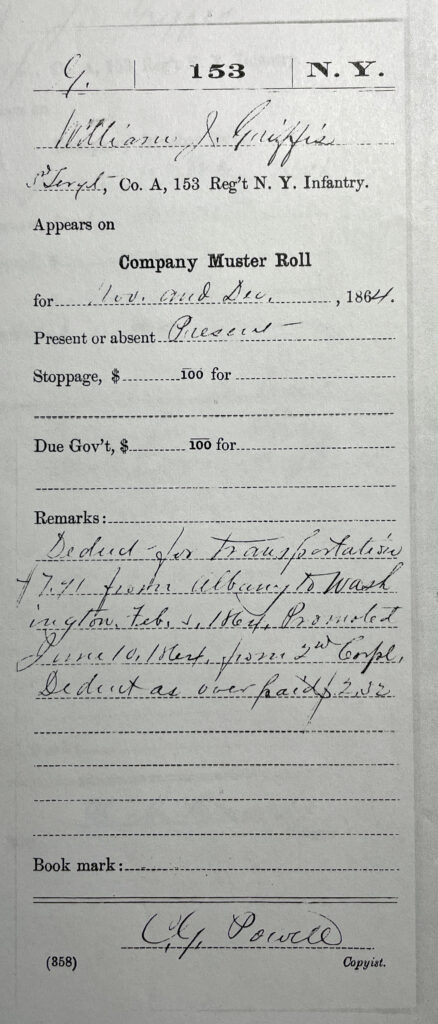
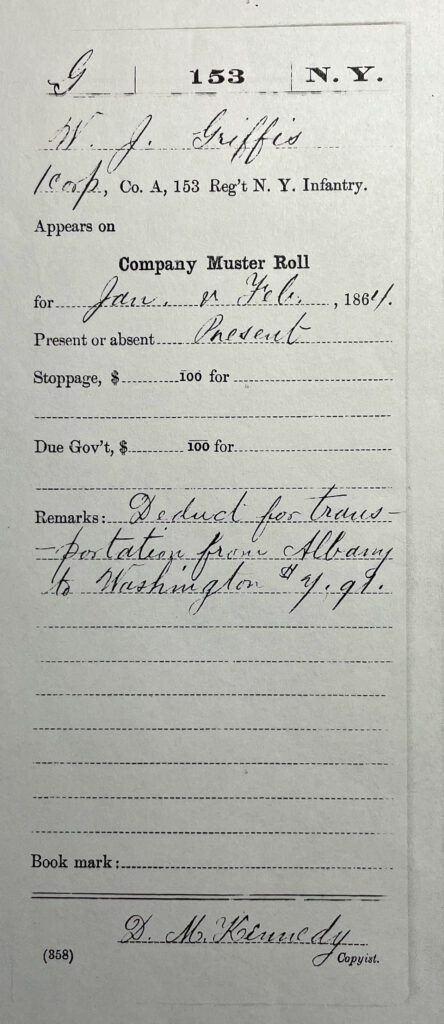
Looking Ahead
At the beginning of 1864, William Griffis was convalesceing at home in January 1864. His older brother Daniel was adapting to his winter quarters at Mitchell’s Station, Virginia. At the beginning of February, 1864, William arrives back in Washington to resume provost guard duty. His brother is 60 miles to the south west at Mitchell’s station, near the Orange And Alexandria Railroad, five miles from the front where the Army of Virgina is across the Rapidan River, engaged with picket duty and working with his mules and wagon. Only 60 miles separate the brothers but they live and experience two totally different worlds.
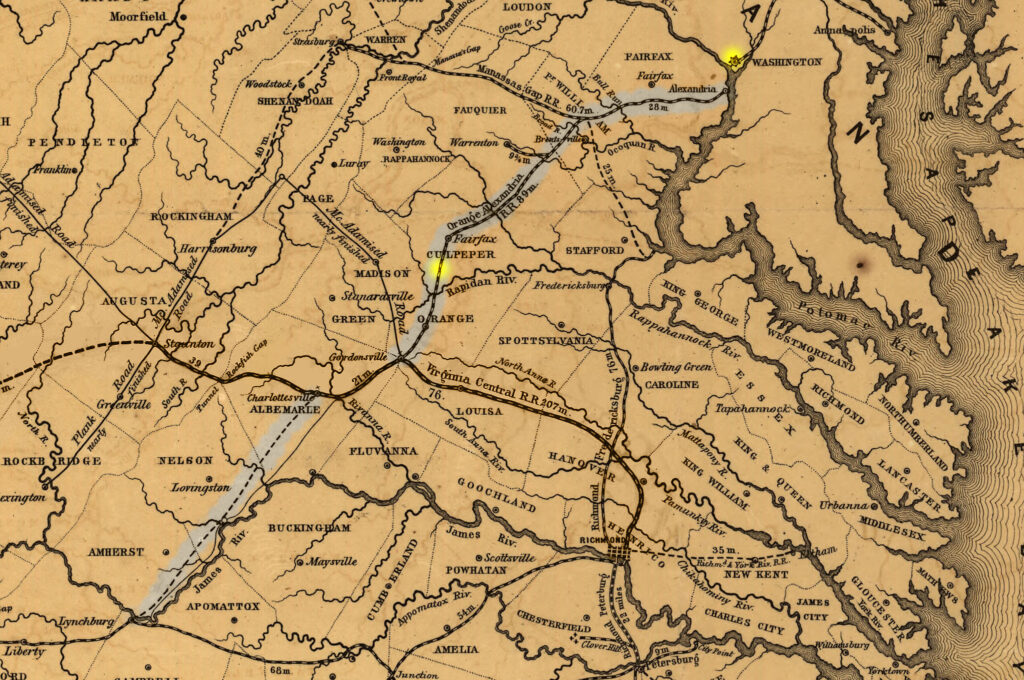
Sources
Featured photograph: E. Sachse & Co., Lithographer. Camps of U.S. troops around Washington City, from S. to W. / Lith. by E. Sachse & Co., Balto. Md. United States Arlington Washington D.C. Virginia, ca. 1861. Washington, D.C.: publ. by C. Bonn. Photograph
[1] James Riley Bowen, Regimental History of the First New York Dragoons, Page 10.
[2] Browning, Judkin and Timothy Silver, An Environmental History of the Civil War, Capel Hill: University of North Carolina Press, 2020, Page 26
[3] James Riley Bowen, Regimental History of the First New York Dragoons, Page 11.
[4] Winkle, Kenneth, Washington: Capital of the Union, Essential Civil War Curriculum. September, 2016
[5] Browning, Judkin & Silver, Timothy, An Environmental History of the Civil War, Chapel Hill: The University of North Carolina Press, 2020, Page 29
[6] James Riley Bowen, Regimental History of the First New York Dragoons, Page 14.
[7] Berler, Anne Karen, A Most Unpleasant Part of your Duties: Military Occupation in Four Southern Cities, 1861-1865, PhD Dissertation, Chapel Hill: University of North Carolina, 2011, Page 3
[8] Ibid, Page 11-12
[9] James Riley Bowen, Regimental History of the First New York Dragoons, Pages 71-72.
[10] Carmichael, Peter S., The War for the Common Soldier: How Men Thought, Fought, and Survived in Civil War Armies, Chapel,Hill: The University of North Carolina Press, 2018, Page 246
[11] James Riley Bowen, Regimental History of the First New York Dragoons Page 75-76.
[12] Ibid, Page 81
[13] Ibid, Page 81
[14] Ibid, Page 89
[15] February 4, 1878 Correspondence from the Pension Office, Department of Interior to Pension Examiners, Request for Furnish Full Medical History of Daniel Griffis, 1st Reg. NYD. Based on the information from the Office of Adjutant General of the U.S. Army, Daniel was documented as present in January and February 1864 as a wagon master.

[16] Butterfield, Brigadier-General Daniel. (1862). Camp and Outpost Duty for Infantry. Originally published in New York NY by Harper & Brothers, Publishers and republished in Mechanicsburg VA by Stackpole books (2003); Velo, James, contributor to the Essential Civil War Curriculum Project , What was the function of a Wagon master in the American Civil War?, Jul 24, 2019 Quora
[17] General Orders 110, Organization of the Volunteer Army of the United States April 29, 1863. The War of the Rebellion: a Compilation of the Official Records of the Union and Confederate Armies, III, Series III
[18] Lindmier, Thomas, The Great Blue Army Wagon: The History of Wheeled Transportation in the Frontier Army, Lexington, KY: Carriage Museum of America, 2009; See also History of the Army Wagon, Wheel and Wagon Shop, Page accessed January 4, 2021 ; Hess, Earl J, Civil War Logistics: A Study of Military Transportation, Baton Rouge: Louisiana University Press, 2017
[19] Lackey, Rodney C., Notes on Civil War Logistics: Facts and Stories, United States Army Transportation Corps and Transportation School, Fort Lee, Virginiano date, Accessed December 15, 2020.
[20] Lindmier, Thomas, The Great Blue Army Wagon: The History of Wheeled Transportation in the Frontier Army, Lexington, KY: Carriage Museum of America, 2009
[21] Lackey, Rodney C., Notes on Civil War Logistics: Facts and Stories, United States Army Transportation Corps and Transportation School, Fort Lee, Virginiano date, Accessed December 15, 2020.
[22] Forbes, Edwin, Artist. Study of a Mule Team and Wagon, With Driver. United States Virginia Culpeper Court House, 1863. Sept. 30. Photograph. https://www.loc.gov/item/2004661595/. ;
Hess, Earl J, Civil War Logistics: A Study of Military Transportation, Baton Rouge: Louisiana University Press, 2017 Page 221
[23] O.R., Series 1, Volume 11, Part 3, pp. 365-366: General Orders Number 153, dated August 10, 1862.
[24] Lackey, Rodney C., Notes on Civil War Logistics: Facts and Stories, United States Army Transportation Corps and Transportation School, Fort Lee, Virginian, date accessed December 15, 2020.
[25] Captain. N. J. Sapington in How to Feed an Army: Published By Authority of the Secretary of War for use in the Army of the United States, Washington, Government Printing Office, 1901, Page 60.
[26] Carpenter, Lieutenant Colonel C. C. (1901) in How To Feed An Army. United States War Department, Washington DC. Government Printing Office, p. 79.
[27] O.R., Series 1, Volume 29 (Part 2), p.472
[28] Ethier, Eric, Behind the Horsepower of Civil War Armies, Civil War Times May, 2007
[29] Butterfield, Brigadier-General Daniel, Camp and Outpost Duty for Infantry. Originally published in New York NY by Harper & Brothers, Publishers (1862) and republished in Mechanicsburg VA by Stackpole books (2003) Page 47.
[30] Ethier, Eric, Behind the Horsepower of Civil War Armies, Civil War Times May, 2007
[31] Ibid
[32] James Riley Bowen, Regimental History of the First New York Dragoons, Page 99.
[33] Ibid, Page 101
[34] Ipid, Page 108
[35] Ibid, Page 112.
[36] Roy P. Basler, ed., The Collected Works of Abraham Lincoln, 10 vols. (New Brunswick, NJ: Rutgers University Press, 1953), 6:226.
[37] Winkle, Kenneth, Washington: Capital of the Union, Essential Civil War Curriculum. September, 2016;
The Fortification System, National Park Service, U.S. Department of Interior, Page updated Aug 27, 2020, page accessed Jan 10, 2021
[38] Winkle, Kenneth, Washington: Capital of the Union, Essential Civil War Curriculum. September, 2016
[39] Steel, Johan, Provost Guard, Civil War Talk, July 31, 2003
[40] The War of the Rebellion: A Compilation of the Official Records of the Union and Confederate Armies, Prepared under the direction of the Secretary of War, by Bvt. Lieut Col. Robert N. Scott, Third U.S. Artillery and published pursuant to Act of Congress Approved June 16, 1880, Washington, Government Printing Office, 1881, Series I Volume 5, page 30
[41] Amy Bertsch, former Public Information Officer, and Lance Mallamo, Director, on behalf of the Office of Historic Alexandria, How sweet it is: from military HQ to bank to bakery, Alexandria Times July 21, 2011
[42] Amy Bertsch, Amy and Lance Mallamo, Out of the Attic: Alexandria cotton mill that became a Civil War torture chamber, Office of Historic Alexandria City of Alexandria, Virginia, Alexandria Times, May 11, 2017.
[43] As the number of African American former slaves, known as contrabands, grew, health became an issue. In February 1863, Military Governor John Slough ordered one part of the building to be turned into a hospital for contrabands. Contraband Hospital and School, Page updated on Mar 8, 202, page accessed Feb 3, 2021.
[44] Water Battery (40 Pounder), “No. 30” handwritten in pencil in top left corner Alternate title derived from captioned print, Library of Congress, Prints & Photographs Division: LOT 4336, no. 62., 1864, City of Alexandria, The Huntington Library, Art Museum, and Botanical Gardens, Huntington Digital Digital Library;
Battery Rodgers, Wikipedia, page was last edited on 24 July 2018Accessed January 30, 2021
Office of Historic Alexandria, Out of the Attic Battery Rodgers Alexandria Times June 3, 2010
[45] History of the Sheriff’s Office, City of Alexandria Website, Page updated on Jan 8, 2019
[46] File 280.194, William J. Griffis Claim for Increase, Bureau of Pensions, letter in reply to a September 11, 1900 Bureau of Pensions request for additional information on facts related to the request for pension increase. This is one example of many affidavits that touch on the chronology of events. The chronology of events is difficult to follow in the letter. In his attempt to be brief and fit his description of William’s physical maladies, John Dye, a fellow soldier and neighbor after the war, strings various events together:
- William had a heavy cold in October 1862 and sent to perform light duty at the Jail.
- When the regiment was transferred to Washginton, D.C. on July 21, 1863, William followed 14 days later and was assigned to the Railroad Depot detail.
- He became sick again was sent to the camp hospital and was there for six weeks and then sent home on medical furlough and returned in February 1864.
- William performed light duty in New Orleans ‘not being able to do picket duty to the close of the war’.

[47] RG 94, Regimental Order Book, 153rd New York Infantry, National Archives
[48] Wakeman, Sarah Rosetta and Lauren Cook Burgess. An uncommon soldier : the Civil War letters of Sarah Rosetta Wakeman, alias Private Lyons Wakeman, 153rd Regiment, New York State Volunteers. Pasadena, Md: The Minerva Center, 1994. Page 23
[49] Goellnitz, Jenny, Common Civil War Medical Terms, Civil War Battlefield Medicine, Ohio State University, e-history, Department of History
The most common symptom of chronic laryngitis is hoarseness. For the condition to be truly chronic, this hoarseness persists for at least two weeks. Evidently William Griffis exhibit hoarseness or the loss of his voice on recurrent occasions during and after the Civil War. Correspondence from his neighbors indicated at times he talked in a whisper. Depending on the cause of chronic laryngitis, other symptoms can include:
- A low, raspy voice
- A voice that tires easily, “breaks” or “cracks”
- The sensation of a lump in the throat or a dry throat
- A constant urge to clear the throat
- Heavy mucus in the throat
- Chronic cough or postnasal drip
- Discomfort during swallowing
Marion Thrasher, Marion, M.D., Chronic Catarrhal Laryngitis, Read by title in the Section of Laryngology and Otology, at the Forty-second Annual Meeting of the American Medical Association, Washington D.C., May 1891.
[50] RG 94, Regimental Order Book, 153rd New York Infantry, National Archives; Special Order No 139, Judy 20, 1863, National Archives
[51] Wakeman, Sarah Rosetta and Lauren Cook Burgess. An uncommon soldier : the Civil War letters of Sarah Rosetta Wakeman, alias Private Lyons Wakeman, 153rd Regiment, New York State Volunteers. Pasadena, Md: The Minerva Center, 1994. Page 40-41
[52] Kelly, Kate, The Civil War Draft Riots Brought Terror to New York’s Streets, Smithsonian Magazine, September 21, 2017;
Harris, Leslie M., In the Shadow of Slavery: African Americans in New York City, 1626-1863, Chicago: University of Chicago Press, 2004;
New York City draft riots, Wikipedia, This page was last edited on December 27, 2020, Page access January 11, 2021;
Schecter, Barnet (2007). “The Civil War Draft Riots“. North & South. Civil War Society. 10 (1): 72.
Fry, James Barnet (1885). New York and the Conscription of 1863. G.P. Putnam’s Sons.
Cook, Adrian (1974). The Armies of the Streets: The New York City Draft Riots of 1863. University Press of Kentucky.
[53] Wakeman, Sarah Rosetta and Lauren Cook Burgess. An uncommon soldier : the Civil War letters of Sarah Rosetta Wakeman, alias Private Lyons Wakeman, 153rd Regiment, New York State Volunteers. Pasadena, Md: The Minerva Center, 1994. Page 46
[54] Washington Depot, with U. S. Capitol in the Distance (1872). From Cushings & Bailey (publisher),Part Of: Photographic views of the Baltimore and Ohio Rail Road and its branches from the lakes to the sea, Southern Methodist University, Central University Libraries, DeGolyer Library http://digitalcollections.smu.edu/cdm/ref/collection/nam/id/317
[55] Architect of the Capital, Capital Dome
[56] Wakeman, Sarah Rosetta and Lauren Cook Burgess. An uncommon soldier : the Civil War letters of Sarah Rosetta Wakeman, alias Private Lyons Wakeman, 153rd Regiment, New York State Volunteers. Pasadena, Md: The Minerva Center, 1994. Page 47
[57] Washington Topham, Washington, First Railroad into Washington and its Three Depots, Records of the Columbia Historical Society, Washington, D.C., Vol. 27 (1925), pp. 175-247 (79 pages) Published by: Historical Society of Washington, D.C. Page 232
[58] Ibid, Page 232
[59] Ibid, Page 230
[60] Desilver, Charles.Cushings & Bailey, (1859) Original Map from the Library of Congress, Geography and Map Division Washington, D.C. See also: https://commons.wikimedia.org/wiki/File:Detail_of_a_1859_Map_of_Washington,_DC_showing_the_B%26O_Railway.png
[61] Hess, Earl J., Civil War Logistics: A Study of Military Transportation, Baton Rouge: Louisiana State University, 2017, Page 120
[62] Brammer, Robert, Old Capitol Prison and the United States Supreme Court, Library of Congress, Law Library, Jan 24, 2020
[63] Wakeman, Sarah Rosetta and Lauren Cook Burgess. An uncommon soldier : the Civil War letters of Sarah Rosetta Wakeman, alias Private Lyons Wakeman, 153rd Regiment, New York State Volunteers. Pasadena, Md: The Minerva Center, 1994. Page 44
[64] Rosters Of The New York Infantry Regiments During The Civil War. Rosters were compiled by the New York State Adjutant General Office. They were published as a set of 43 volumes between 1893 and 1905. Their official titles are Annual Report of the Adjutant-General of the State of New York for the Year … : Registers of the [units numbers].
Infantry in the American Civil War, Wikipedia, This page was last edited on 22 January 2021, page accessed 12 Feb 2021
[65] File 280.194, William J. Griffis Claim for Increase, Bureau of Pensions, Department of Interior, Sep 3, 1883 letter by John Brownell
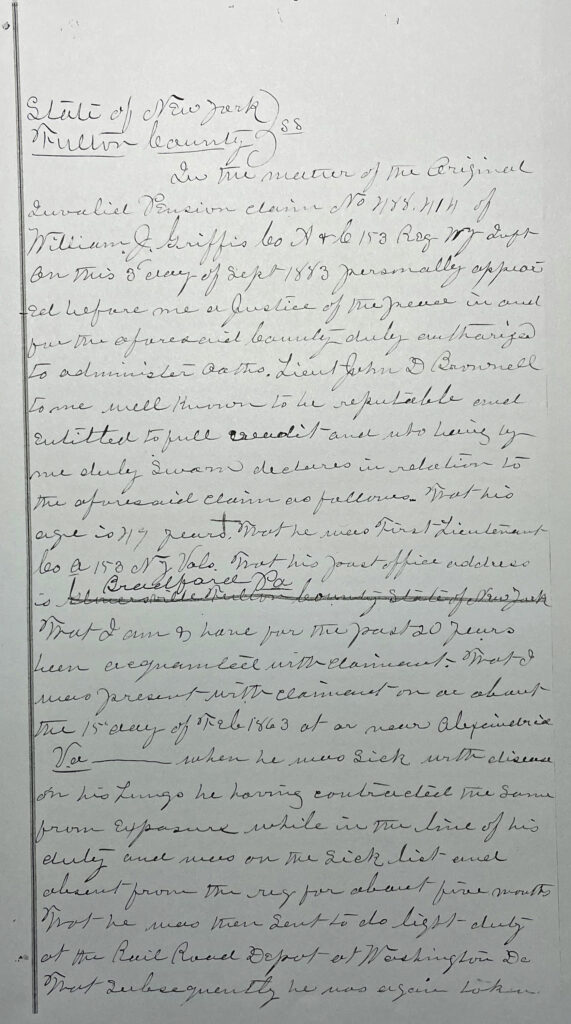
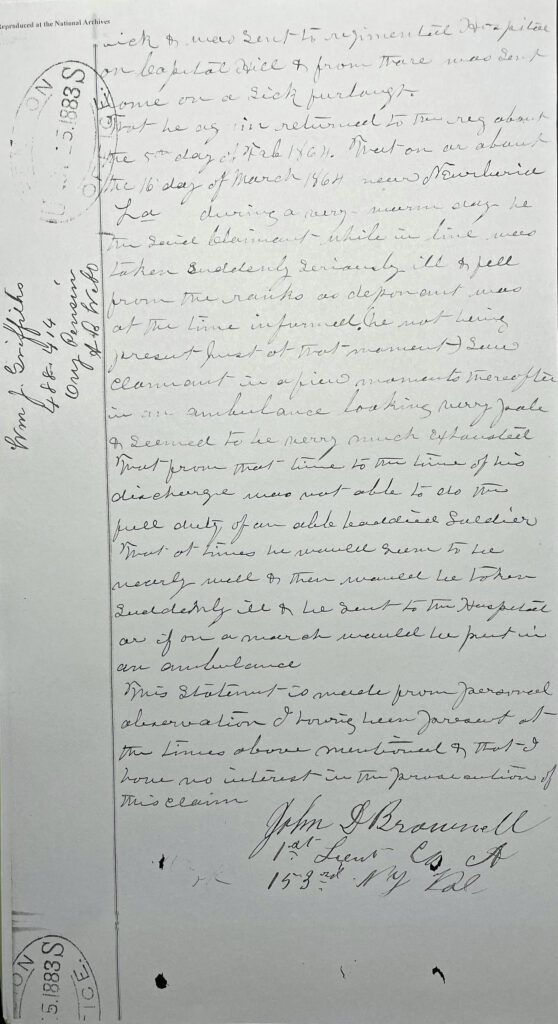
[66] William Osler, The Principles and Practice of Medicine, 3rd ed. (New York, 1898), 108-137; Smart, Charles, ed. The Medical and Surgical History of the War of the Rebellion (Washington, D.C., 1888), pt. 3, vol. 1, 751-810
[67] Lively, Mathew, “The Most Fatal of All Acute Diseases:” Pneumonia and the Death of Stonewall Jackson May 13, 2013, Civil War Monitor
[68] Michael A. Flannery, Michael A., Civil War Pharmacy: A History. Carbondale, IL: South Illinois Press, 2004, Page 22
[69] Phisterer, CPT. Frederick. (1883 and 2002). Statistical Record of the Armies of the United States. The 2002 edition was published in Edison NJ by Castle books. p. 63.
[70] Sherman, General W. T. , The Grand Strategy of the War of the Rebellion. The Century, Vollume 35, Issue 4, Feb. 1888, p.54.
[71] Lawrence, Susan, Organization of the Hospitals in the Department of Washington, Civil War Washington, directed by Susan C. Lawrence, Elizabeth Lorang, Kenneth M. Price, and Kenneth J. Winkle, is published by the Center for Digital Research in the Humanities at the University of Nebraska-Lincoln
Lawrence, Susan C., Military Hospitals in the Department of Washington, Civil War Washington, directed by Susan C. Lawrence, Elizabeth Lorang, Kenneth M. Price, and Kenneth J. Winkle, is published by the Center for Digital Research in the Humanities at the University of Nebraska-Lincoln




